Assignment - International Economics
VerifiedAdded on 2021/07/20
|27
|10384
|248
AI Summary
Contribute Materials
Your contribution can guide someone’s learning journey. Share your
documents today.
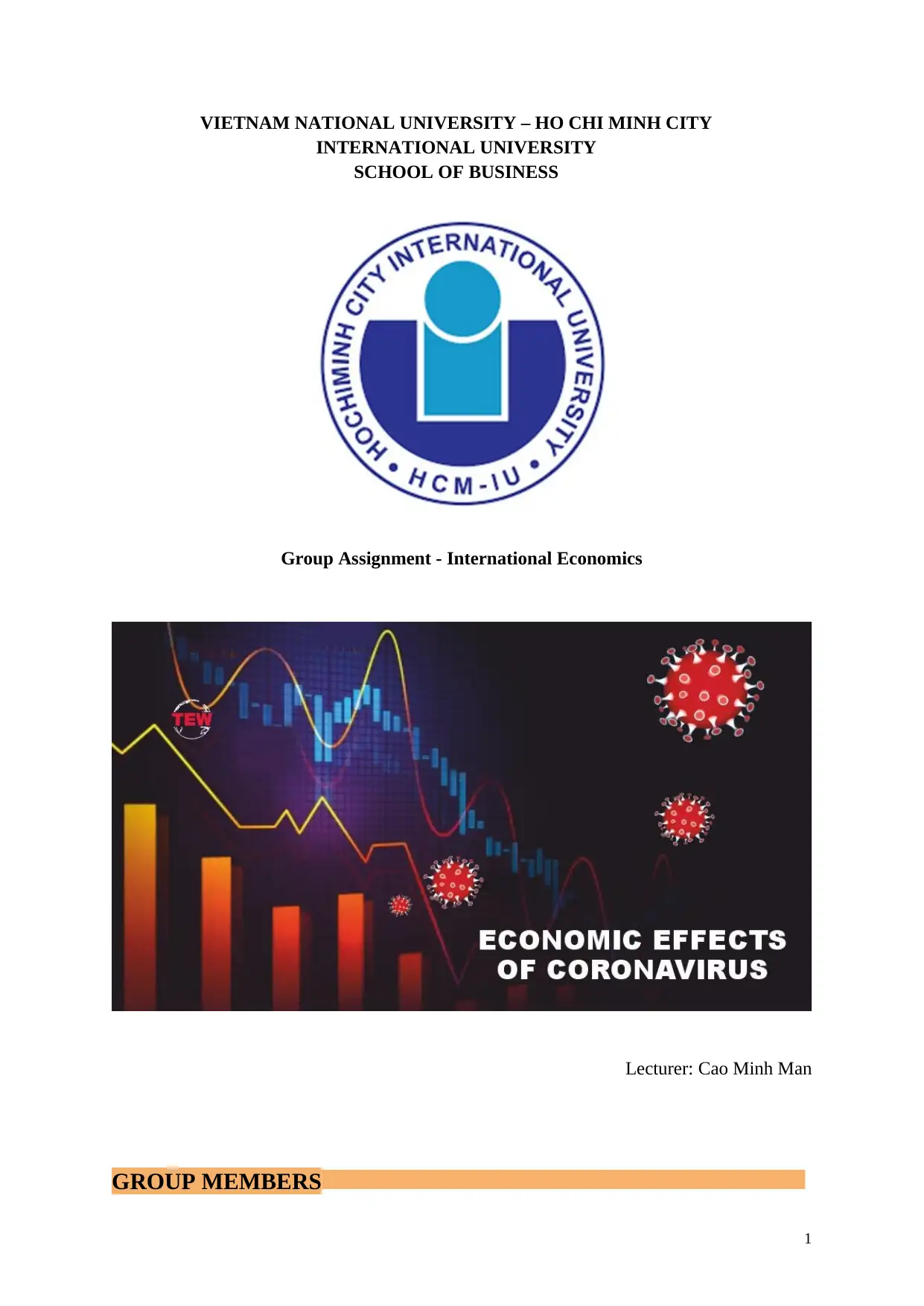
VIETNAM NATIONAL UNIVERSITY – HO CHI MINH CITY
INTERNATIONAL UNIVERSITY
SCHOOL OF BUSINESS
Group Assignment - International Economics
Lecturer: Cao Minh Man
GROUP MEMBERS
1
INTERNATIONAL UNIVERSITY
SCHOOL OF BUSINESS
Group Assignment - International Economics
Lecturer: Cao Minh Man
GROUP MEMBERS
1
Secure Best Marks with AI Grader
Need help grading? Try our AI Grader for instant feedback on your assignments.
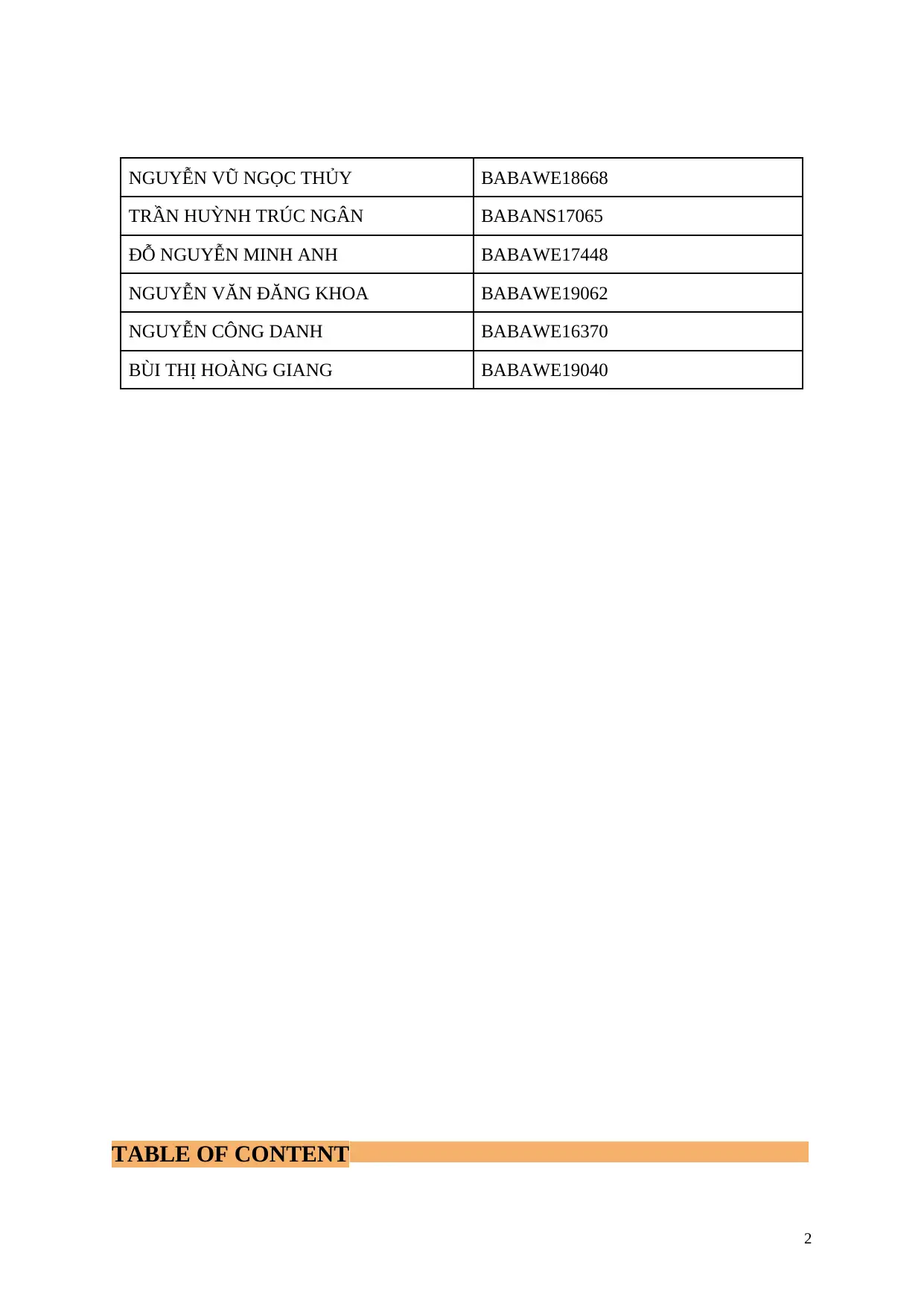
NGUYỄN VŨ NGỌC THỦY BABAWE18668
TRẦN HUỲNH TRÚC NGÂN BABANS17065
ĐỖ NGUYỄN MINH ANH BABAWE17448
NGUYỄN VĂN ĐĂNG KHOA BABAWE19062
NGUYỄN CÔNG DANH BABAWE16370
BÙI THỊ HOÀNG GIANG BABAWE19040
TABLE OF CONTENT
2
TRẦN HUỲNH TRÚC NGÂN BABANS17065
ĐỖ NGUYỄN MINH ANH BABAWE17448
NGUYỄN VĂN ĐĂNG KHOA BABAWE19062
NGUYỄN CÔNG DANH BABAWE16370
BÙI THỊ HOÀNG GIANG BABAWE19040
TABLE OF CONTENT
2
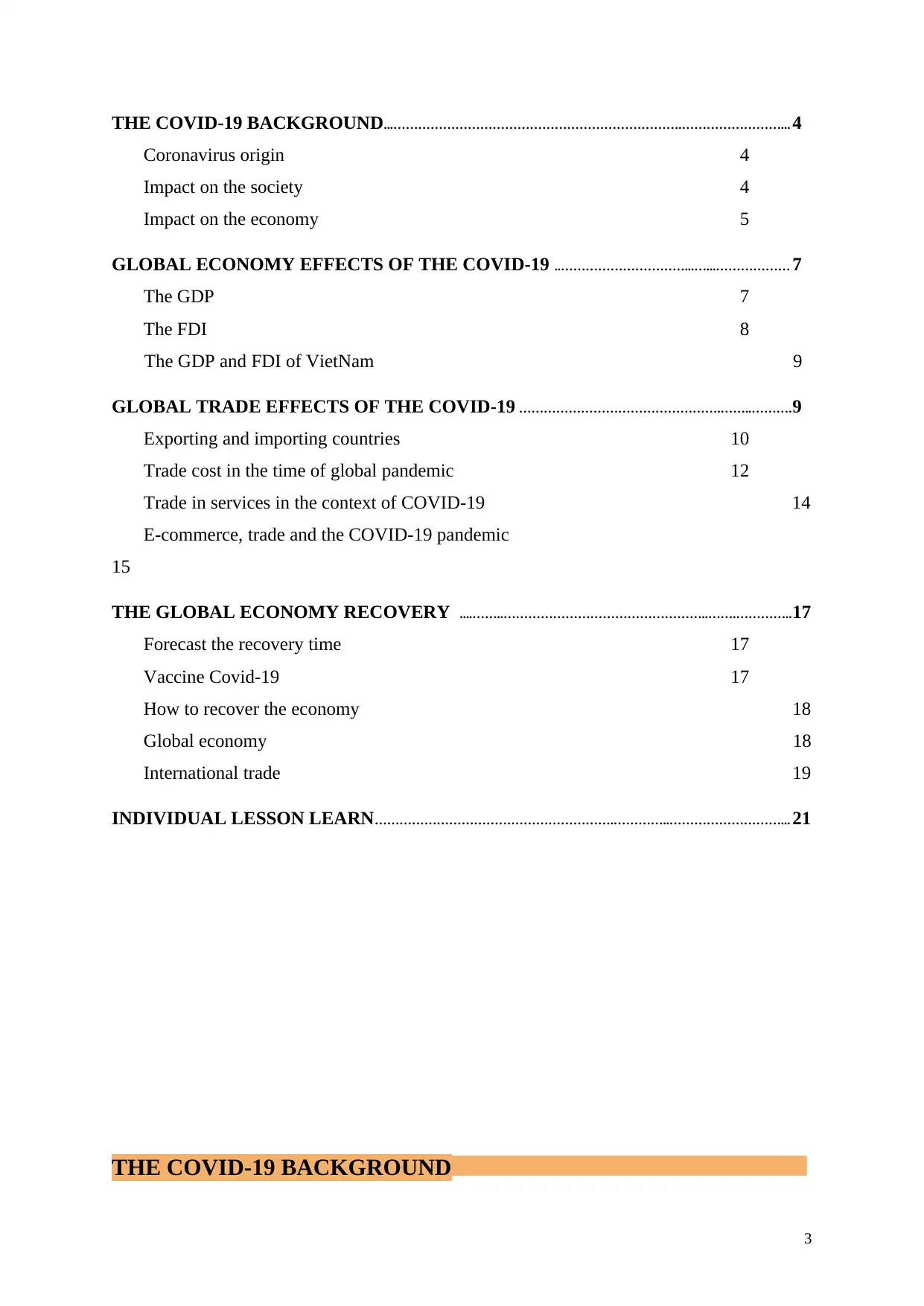
THE COVID-19 BACKGROUND...…………………………………………………………….……………………... 4
Coronavirus origin 4
Impact on the society 4
Impact on the economy 5
GLOBAL ECONOMY EFFECTS OF THE COVID-19 ..…………………………...…...……………… 7
The GDP 7
The FDI 8
The GDP and FDI of VietNam 9
GLOBAL TRADE EFFECTS OF THE COVID-19 ………………………………………….……..……….9
Exporting and importing countries 10
Trade cost in the time of global pandemic 12
Trade in services in the context of COVID-19 14
E-commerce, trade and the COVID-19 pandemic
15
THE GLOBAL ECONOMY RECOVERY ....……..…………………………………………..…….…………..17
Forecast the recovery time 17
Vaccine Covid-19 17
How to recover the economy 18
Global economy 18
International trade 19
INDIVIDUAL LESSON LEARN………………………………………………….…………..………………………... 21
THE COVID-19 BACKGROUND
3
Coronavirus origin 4
Impact on the society 4
Impact on the economy 5
GLOBAL ECONOMY EFFECTS OF THE COVID-19 ..…………………………...…...……………… 7
The GDP 7
The FDI 8
The GDP and FDI of VietNam 9
GLOBAL TRADE EFFECTS OF THE COVID-19 ………………………………………….……..……….9
Exporting and importing countries 10
Trade cost in the time of global pandemic 12
Trade in services in the context of COVID-19 14
E-commerce, trade and the COVID-19 pandemic
15
THE GLOBAL ECONOMY RECOVERY ....……..…………………………………………..…….…………..17
Forecast the recovery time 17
Vaccine Covid-19 17
How to recover the economy 18
Global economy 18
International trade 19
INDIVIDUAL LESSON LEARN………………………………………………….…………..………………………... 21
THE COVID-19 BACKGROUND
3
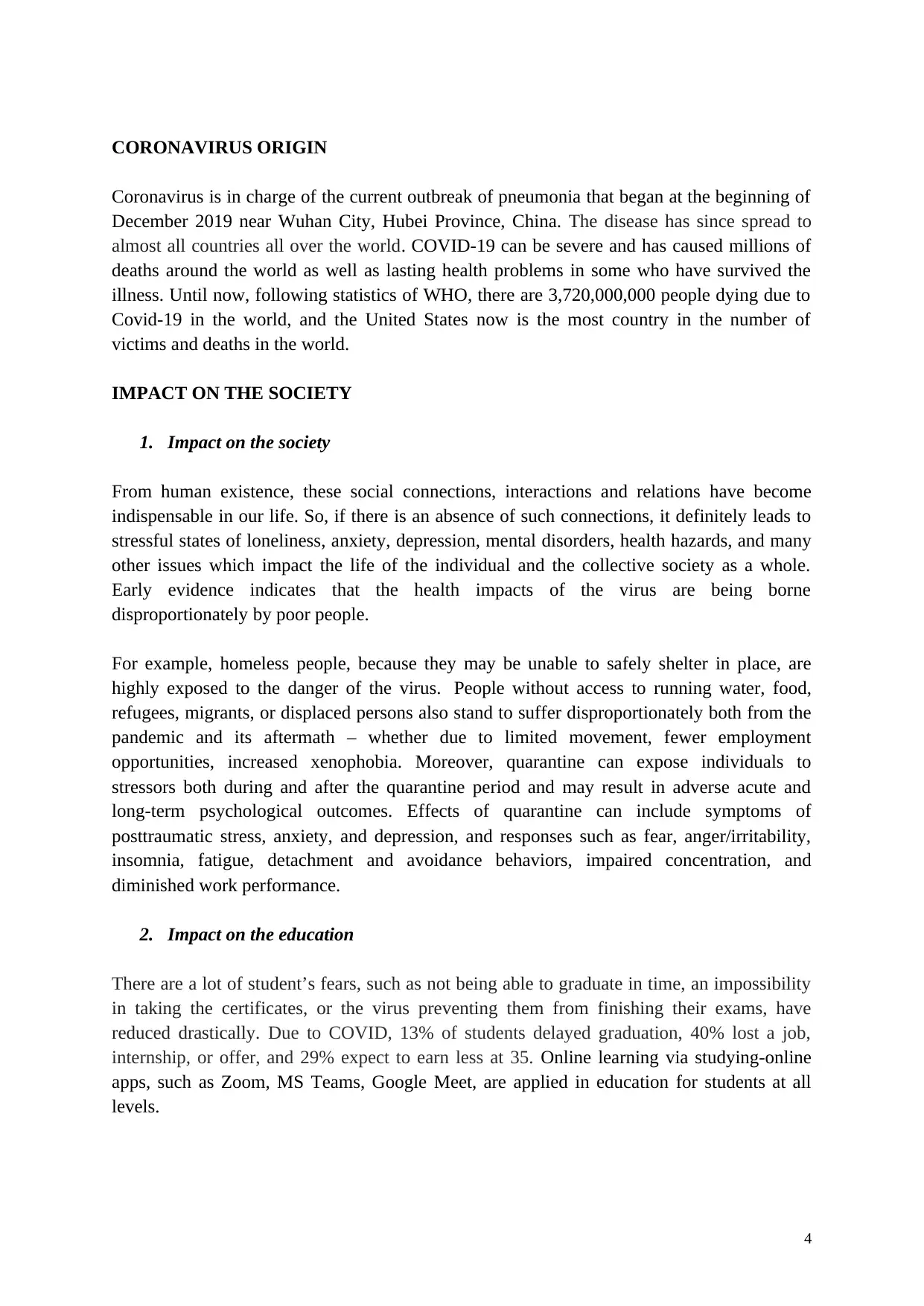
CORONAVIRUS ORIGIN
Coronavirus is in charge of the current outbreak of pneumonia that began at the beginning of
December 2019 near Wuhan City, Hubei Province, China. The disease has since spread to
almost all countries all over the world. COVID-19 can be severe and has caused millions of
deaths around the world as well as lasting health problems in some who have survived the
illness. Until now, following statistics of WHO, there are 3,720,000,000 people dying due to
Covid-19 in the world, and the United States now is the most country in the number of
victims and deaths in the world.
IMPACT ON THE SOCIETY
1. Impact on the society
From human existence, these social connections, interactions and relations have become
indispensable in our life. So, if there is an absence of such connections, it definitely leads to
stressful states of loneliness, anxiety, depression, mental disorders, health hazards, and many
other issues which impact the life of the individual and the collective society as a whole.
Early evidence indicates that the health impacts of the virus are being borne
disproportionately by poor people.
For example, homeless people, because they may be unable to safely shelter in place, are
highly exposed to the danger of the virus. People without access to running water, food,
refugees, migrants, or displaced persons also stand to suffer disproportionately both from the
pandemic and its aftermath – whether due to limited movement, fewer employment
opportunities, increased xenophobia. Moreover, quarantine can expose individuals to
stressors both during and after the quarantine period and may result in adverse acute and
long-term psychological outcomes. Effects of quarantine can include symptoms of
posttraumatic stress, anxiety, and depression, and responses such as fear, anger/irritability,
insomnia, fatigue, detachment and avoidance behaviors, impaired concentration, and
diminished work performance.
2. Impact on the education
There are a lot of student’s fears, such as not being able to graduate in time, an impossibility
in taking the certificates, or the virus preventing them from finishing their exams, have
reduced drastically. Due to COVID, 13% of students delayed graduation, 40% lost a job,
internship, or offer, and 29% expect to earn less at 35. Online learning via studying-online
apps, such as Zoom, MS Teams, Google Meet, are applied in education for students at all
levels.
4
Coronavirus is in charge of the current outbreak of pneumonia that began at the beginning of
December 2019 near Wuhan City, Hubei Province, China. The disease has since spread to
almost all countries all over the world. COVID-19 can be severe and has caused millions of
deaths around the world as well as lasting health problems in some who have survived the
illness. Until now, following statistics of WHO, there are 3,720,000,000 people dying due to
Covid-19 in the world, and the United States now is the most country in the number of
victims and deaths in the world.
IMPACT ON THE SOCIETY
1. Impact on the society
From human existence, these social connections, interactions and relations have become
indispensable in our life. So, if there is an absence of such connections, it definitely leads to
stressful states of loneliness, anxiety, depression, mental disorders, health hazards, and many
other issues which impact the life of the individual and the collective society as a whole.
Early evidence indicates that the health impacts of the virus are being borne
disproportionately by poor people.
For example, homeless people, because they may be unable to safely shelter in place, are
highly exposed to the danger of the virus. People without access to running water, food,
refugees, migrants, or displaced persons also stand to suffer disproportionately both from the
pandemic and its aftermath – whether due to limited movement, fewer employment
opportunities, increased xenophobia. Moreover, quarantine can expose individuals to
stressors both during and after the quarantine period and may result in adverse acute and
long-term psychological outcomes. Effects of quarantine can include symptoms of
posttraumatic stress, anxiety, and depression, and responses such as fear, anger/irritability,
insomnia, fatigue, detachment and avoidance behaviors, impaired concentration, and
diminished work performance.
2. Impact on the education
There are a lot of student’s fears, such as not being able to graduate in time, an impossibility
in taking the certificates, or the virus preventing them from finishing their exams, have
reduced drastically. Due to COVID, 13% of students delayed graduation, 40% lost a job,
internship, or offer, and 29% expect to earn less at 35. Online learning via studying-online
apps, such as Zoom, MS Teams, Google Meet, are applied in education for students at all
levels.
4
Secure Best Marks with AI Grader
Need help grading? Try our AI Grader for instant feedback on your assignments.
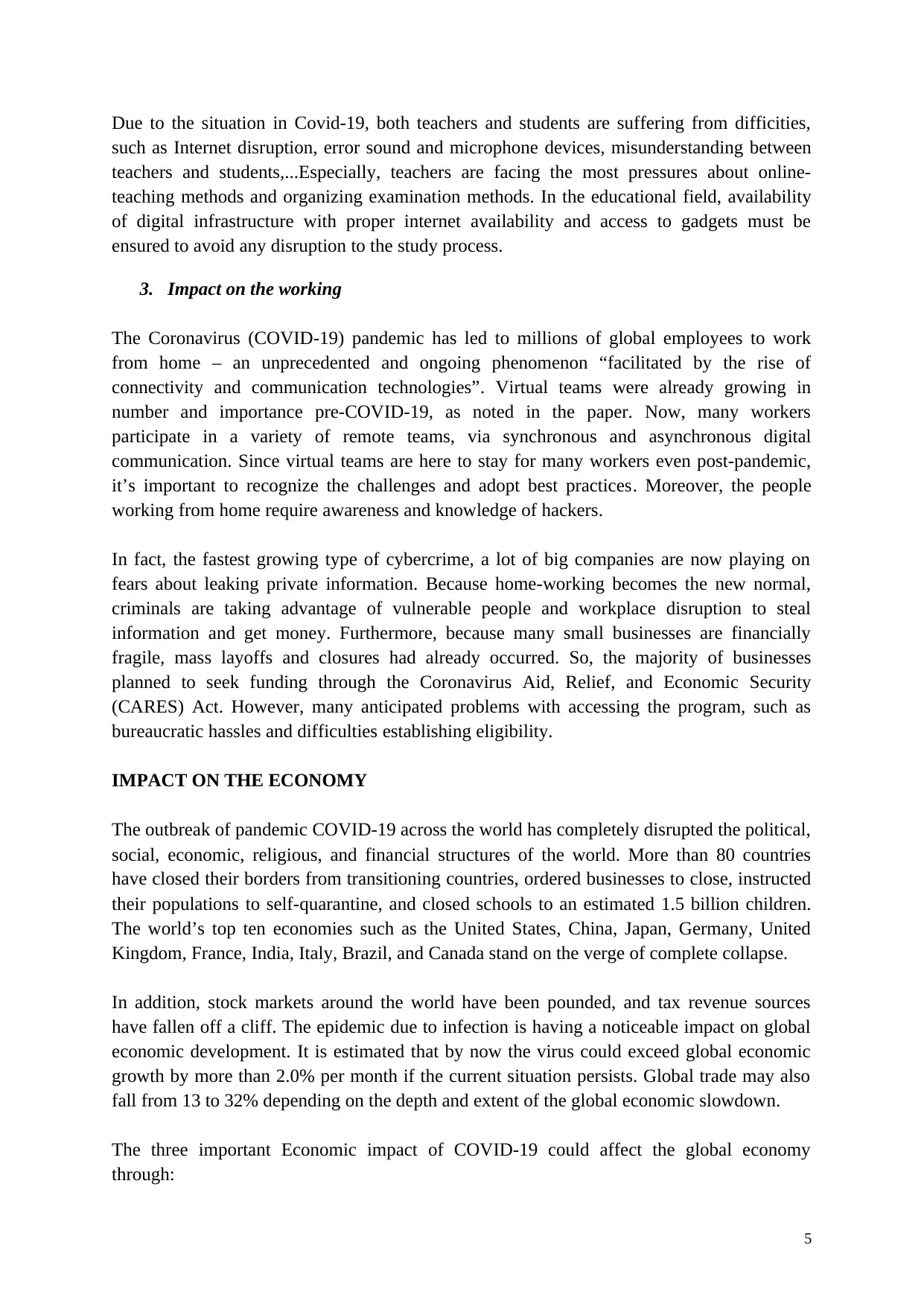
Due to the situation in Covid-19, both teachers and students are suffering from difficities,
such as Internet disruption, error sound and microphone devices, misunderstanding between
teachers and students,...Especially, teachers are facing the most pressures about online-
teaching methods and organizing examination methods. In the educational field, availability
of digital infrastructure with proper internet availability and access to gadgets must be
ensured to avoid any disruption to the study process.
3. Impact on the working
The Coronavirus (COVID-19) pandemic has led to millions of global employees to work
from home – an unprecedented and ongoing phenomenon “facilitated by the rise of
connectivity and communication technologies”. Virtual teams were already growing in
number and importance pre-COVID-19, as noted in the paper. Now, many workers
participate in a variety of remote teams, via synchronous and asynchronous digital
communication. Since virtual teams are here to stay for many workers even post-pandemic,
it’s important to recognize the challenges and adopt best practices. Moreover, the people
working from home require awareness and knowledge of hackers.
In fact, the fastest growing type of cybercrime, a lot of big companies are now playing on
fears about leaking private information. Because home-working becomes the new normal,
criminals are taking advantage of vulnerable people and workplace disruption to steal
information and get money. Furthermore, because many small businesses are financially
fragile, mass layoffs and closures had already occurred. So, the majority of businesses
planned to seek funding through the Coronavirus Aid, Relief, and Economic Security
(CARES) Act. However, many anticipated problems with accessing the program, such as
bureaucratic hassles and difficulties establishing eligibility.
IMPACT ON THE ECONOMY
The outbreak of pandemic COVID-19 across the world has completely disrupted the political,
social, economic, religious, and financial structures of the world. More than 80 countries
have closed their borders from transitioning countries, ordered businesses to close, instructed
their populations to self-quarantine, and closed schools to an estimated 1.5 billion children.
The world’s top ten economies such as the United States, China, Japan, Germany, United
Kingdom, France, India, Italy, Brazil, and Canada stand on the verge of complete collapse.
In addition, stock markets around the world have been pounded, and tax revenue sources
have fallen off a cliff. The epidemic due to infection is having a noticeable impact on global
economic development. It is estimated that by now the virus could exceed global economic
growth by more than 2.0% per month if the current situation persists. Global trade may also
fall from 13 to 32% depending on the depth and extent of the global economic slowdown.
The three important Economic impact of COVID-19 could affect the global economy
through:
5
such as Internet disruption, error sound and microphone devices, misunderstanding between
teachers and students,...Especially, teachers are facing the most pressures about online-
teaching methods and organizing examination methods. In the educational field, availability
of digital infrastructure with proper internet availability and access to gadgets must be
ensured to avoid any disruption to the study process.
3. Impact on the working
The Coronavirus (COVID-19) pandemic has led to millions of global employees to work
from home – an unprecedented and ongoing phenomenon “facilitated by the rise of
connectivity and communication technologies”. Virtual teams were already growing in
number and importance pre-COVID-19, as noted in the paper. Now, many workers
participate in a variety of remote teams, via synchronous and asynchronous digital
communication. Since virtual teams are here to stay for many workers even post-pandemic,
it’s important to recognize the challenges and adopt best practices. Moreover, the people
working from home require awareness and knowledge of hackers.
In fact, the fastest growing type of cybercrime, a lot of big companies are now playing on
fears about leaking private information. Because home-working becomes the new normal,
criminals are taking advantage of vulnerable people and workplace disruption to steal
information and get money. Furthermore, because many small businesses are financially
fragile, mass layoffs and closures had already occurred. So, the majority of businesses
planned to seek funding through the Coronavirus Aid, Relief, and Economic Security
(CARES) Act. However, many anticipated problems with accessing the program, such as
bureaucratic hassles and difficulties establishing eligibility.
IMPACT ON THE ECONOMY
The outbreak of pandemic COVID-19 across the world has completely disrupted the political,
social, economic, religious, and financial structures of the world. More than 80 countries
have closed their borders from transitioning countries, ordered businesses to close, instructed
their populations to self-quarantine, and closed schools to an estimated 1.5 billion children.
The world’s top ten economies such as the United States, China, Japan, Germany, United
Kingdom, France, India, Italy, Brazil, and Canada stand on the verge of complete collapse.
In addition, stock markets around the world have been pounded, and tax revenue sources
have fallen off a cliff. The epidemic due to infection is having a noticeable impact on global
economic development. It is estimated that by now the virus could exceed global economic
growth by more than 2.0% per month if the current situation persists. Global trade may also
fall from 13 to 32% depending on the depth and extent of the global economic slowdown.
The three important Economic impact of COVID-19 could affect the global economy
through:
5
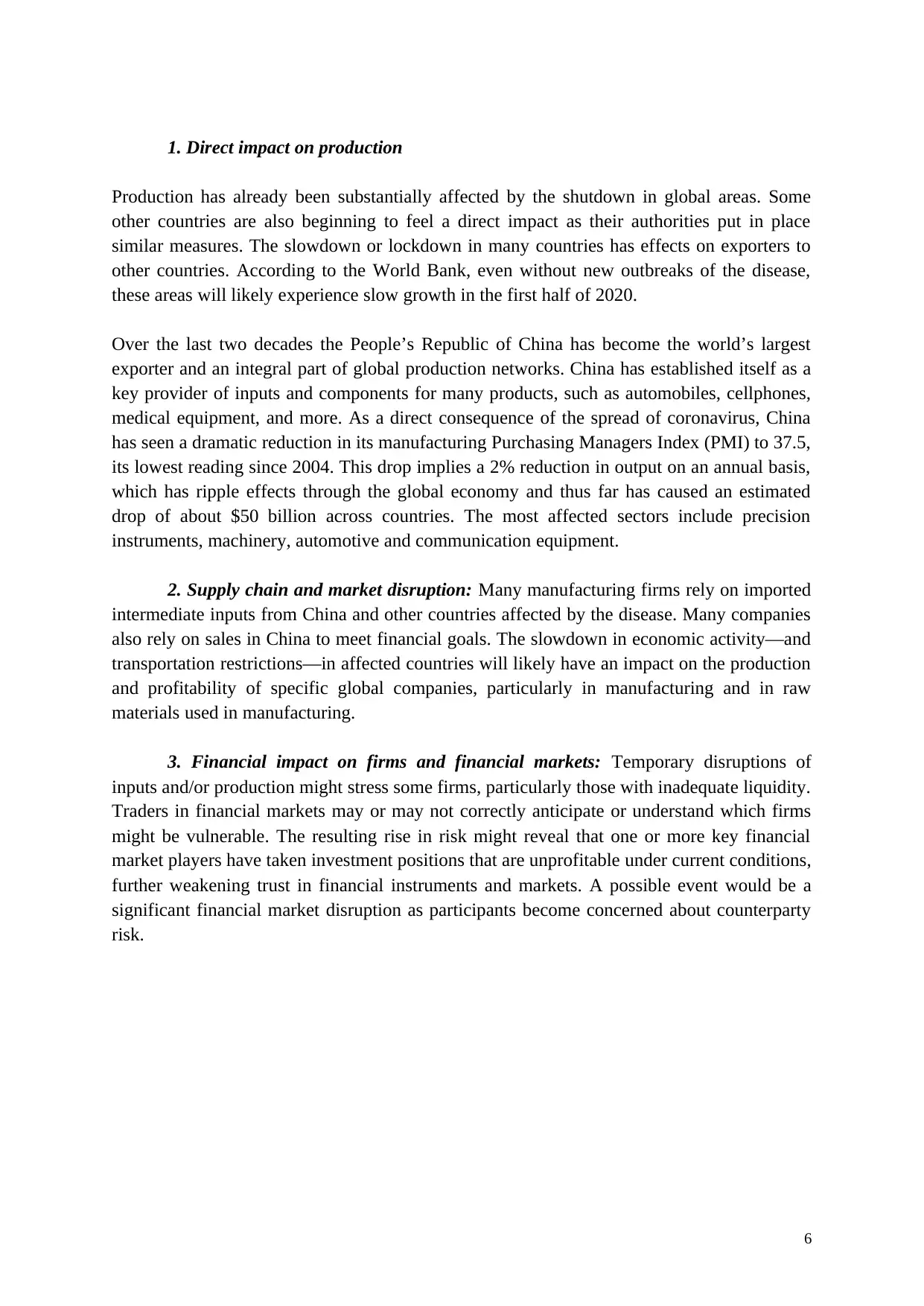
1. Direct impact on production
Production has already been substantially affected by the shutdown in global areas. Some
other countries are also beginning to feel a direct impact as their authorities put in place
similar measures. The slowdown or lockdown in many countries has effects on exporters to
other countries. According to the World Bank, even without new outbreaks of the disease,
these areas will likely experience slow growth in the first half of 2020.
Over the last two decades the People’s Republic of China has become the world’s largest
exporter and an integral part of global production networks. China has established itself as a
key provider of inputs and components for many products, such as automobiles, cellphones,
medical equipment, and more. As a direct consequence of the spread of coronavirus, China
has seen a dramatic reduction in its manufacturing Purchasing Managers Index (PMI) to 37.5,
its lowest reading since 2004. This drop implies a 2% reduction in output on an annual basis,
which has ripple effects through the global economy and thus far has caused an estimated
drop of about $50 billion across countries. The most affected sectors include precision
instruments, machinery, automotive and communication equipment.
2. Supply chain and market disruption: Many manufacturing firms rely on imported
intermediate inputs from China and other countries affected by the disease. Many companies
also rely on sales in China to meet financial goals. The slowdown in economic activity—and
transportation restrictions—in affected countries will likely have an impact on the production
and profitability of specific global companies, particularly in manufacturing and in raw
materials used in manufacturing.
3. Financial impact on firms and financial markets: Temporary disruptions of
inputs and/or production might stress some firms, particularly those with inadequate liquidity.
Traders in financial markets may or may not correctly anticipate or understand which firms
might be vulnerable. The resulting rise in risk might reveal that one or more key financial
market players have taken investment positions that are unprofitable under current conditions,
further weakening trust in financial instruments and markets. A possible event would be a
significant financial market disruption as participants become concerned about counterparty
risk.
6
Production has already been substantially affected by the shutdown in global areas. Some
other countries are also beginning to feel a direct impact as their authorities put in place
similar measures. The slowdown or lockdown in many countries has effects on exporters to
other countries. According to the World Bank, even without new outbreaks of the disease,
these areas will likely experience slow growth in the first half of 2020.
Over the last two decades the People’s Republic of China has become the world’s largest
exporter and an integral part of global production networks. China has established itself as a
key provider of inputs and components for many products, such as automobiles, cellphones,
medical equipment, and more. As a direct consequence of the spread of coronavirus, China
has seen a dramatic reduction in its manufacturing Purchasing Managers Index (PMI) to 37.5,
its lowest reading since 2004. This drop implies a 2% reduction in output on an annual basis,
which has ripple effects through the global economy and thus far has caused an estimated
drop of about $50 billion across countries. The most affected sectors include precision
instruments, machinery, automotive and communication equipment.
2. Supply chain and market disruption: Many manufacturing firms rely on imported
intermediate inputs from China and other countries affected by the disease. Many companies
also rely on sales in China to meet financial goals. The slowdown in economic activity—and
transportation restrictions—in affected countries will likely have an impact on the production
and profitability of specific global companies, particularly in manufacturing and in raw
materials used in manufacturing.
3. Financial impact on firms and financial markets: Temporary disruptions of
inputs and/or production might stress some firms, particularly those with inadequate liquidity.
Traders in financial markets may or may not correctly anticipate or understand which firms
might be vulnerable. The resulting rise in risk might reveal that one or more key financial
market players have taken investment positions that are unprofitable under current conditions,
further weakening trust in financial instruments and markets. A possible event would be a
significant financial market disruption as participants become concerned about counterparty
risk.
6
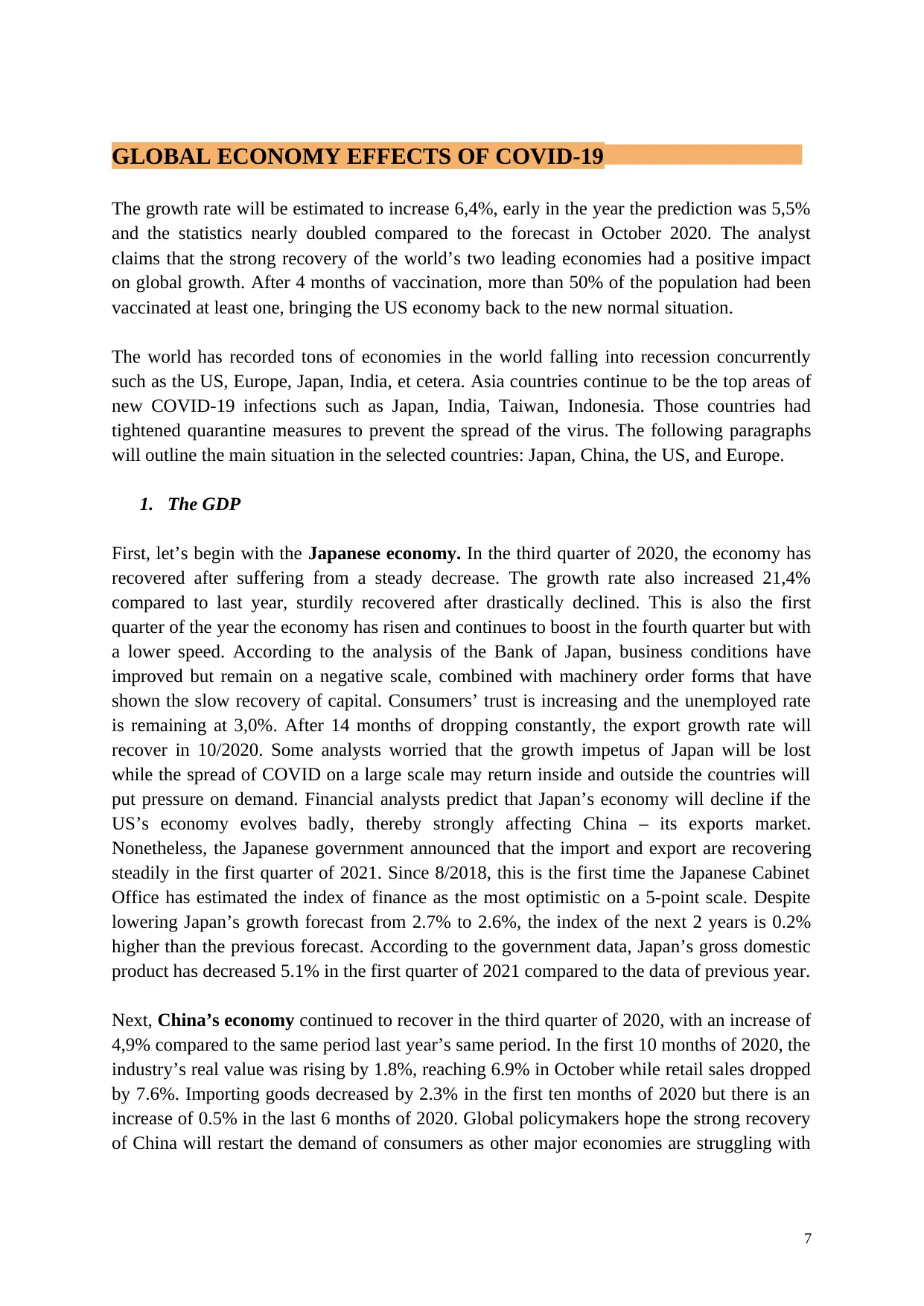
GLOBAL ECONOMY EFFECTS OF COVID-19
The growth rate will be estimated to increase 6,4%, early in the year the prediction was 5,5%
and the statistics nearly doubled compared to the forecast in October 2020. The analyst
claims that the strong recovery of the world’s two leading economies had a positive impact
on global growth. After 4 months of vaccination, more than 50% of the population had been
vaccinated at least one, bringing the US economy back to the new normal situation.
The world has recorded tons of economies in the world falling into recession concurrently
such as the US, Europe, Japan, India, et cetera. Asia countries continue to be the top areas of
new COVID-19 infections such as Japan, India, Taiwan, Indonesia. Those countries had
tightened quarantine measures to prevent the spread of the virus. The following paragraphs
will outline the main situation in the selected countries: Japan, China, the US, and Europe.
1. The GDP
First, let’s begin with the Japanese economy. In the third quarter of 2020, the economy has
recovered after suffering from a steady decrease. The growth rate also increased 21,4%
compared to last year, sturdily recovered after drastically declined. This is also the first
quarter of the year the economy has risen and continues to boost in the fourth quarter but with
a lower speed. According to the analysis of the Bank of Japan, business conditions have
improved but remain on a negative scale, combined with machinery order forms that have
shown the slow recovery of capital. Consumers’ trust is increasing and the unemployed rate
is remaining at 3,0%. After 14 months of dropping constantly, the export growth rate will
recover in 10/2020. Some analysts worried that the growth impetus of Japan will be lost
while the spread of COVID on a large scale may return inside and outside the countries will
put pressure on demand. Financial analysts predict that Japan’s economy will decline if the
US’s economy evolves badly, thereby strongly affecting China – its exports market.
Nonetheless, the Japanese government announced that the import and export are recovering
steadily in the first quarter of 2021. Since 8/2018, this is the first time the Japanese Cabinet
Office has estimated the index of finance as the most optimistic on a 5-point scale. Despite
lowering Japan’s growth forecast from 2.7% to 2.6%, the index of the next 2 years is 0.2%
higher than the previous forecast. According to the government data, Japan’s gross domestic
product has decreased 5.1% in the first quarter of 2021 compared to the data of previous year.
Next, China’s economy continued to recover in the third quarter of 2020, with an increase of
4,9% compared to the same period last year’s same period. In the first 10 months of 2020, the
industry’s real value was rising by 1.8%, reaching 6.9% in October while retail sales dropped
by 7.6%. Importing goods decreased by 2.3% in the first ten months of 2020 but there is an
increase of 0.5% in the last 6 months of 2020. Global policymakers hope the strong recovery
of China will restart the demand of consumers as other major economies are struggling with
7
The growth rate will be estimated to increase 6,4%, early in the year the prediction was 5,5%
and the statistics nearly doubled compared to the forecast in October 2020. The analyst
claims that the strong recovery of the world’s two leading economies had a positive impact
on global growth. After 4 months of vaccination, more than 50% of the population had been
vaccinated at least one, bringing the US economy back to the new normal situation.
The world has recorded tons of economies in the world falling into recession concurrently
such as the US, Europe, Japan, India, et cetera. Asia countries continue to be the top areas of
new COVID-19 infections such as Japan, India, Taiwan, Indonesia. Those countries had
tightened quarantine measures to prevent the spread of the virus. The following paragraphs
will outline the main situation in the selected countries: Japan, China, the US, and Europe.
1. The GDP
First, let’s begin with the Japanese economy. In the third quarter of 2020, the economy has
recovered after suffering from a steady decrease. The growth rate also increased 21,4%
compared to last year, sturdily recovered after drastically declined. This is also the first
quarter of the year the economy has risen and continues to boost in the fourth quarter but with
a lower speed. According to the analysis of the Bank of Japan, business conditions have
improved but remain on a negative scale, combined with machinery order forms that have
shown the slow recovery of capital. Consumers’ trust is increasing and the unemployed rate
is remaining at 3,0%. After 14 months of dropping constantly, the export growth rate will
recover in 10/2020. Some analysts worried that the growth impetus of Japan will be lost
while the spread of COVID on a large scale may return inside and outside the countries will
put pressure on demand. Financial analysts predict that Japan’s economy will decline if the
US’s economy evolves badly, thereby strongly affecting China – its exports market.
Nonetheless, the Japanese government announced that the import and export are recovering
steadily in the first quarter of 2021. Since 8/2018, this is the first time the Japanese Cabinet
Office has estimated the index of finance as the most optimistic on a 5-point scale. Despite
lowering Japan’s growth forecast from 2.7% to 2.6%, the index of the next 2 years is 0.2%
higher than the previous forecast. According to the government data, Japan’s gross domestic
product has decreased 5.1% in the first quarter of 2021 compared to the data of previous year.
Next, China’s economy continued to recover in the third quarter of 2020, with an increase of
4,9% compared to the same period last year’s same period. In the first 10 months of 2020, the
industry’s real value was rising by 1.8%, reaching 6.9% in October while retail sales dropped
by 7.6%. Importing goods decreased by 2.3% in the first ten months of 2020 but there is an
increase of 0.5% in the last 6 months of 2020. Global policymakers hope the strong recovery
of China will restart the demand of consumers as other major economies are struggling with
7
Paraphrase This Document
Need a fresh take? Get an instant paraphrase of this document with our AI Paraphraser
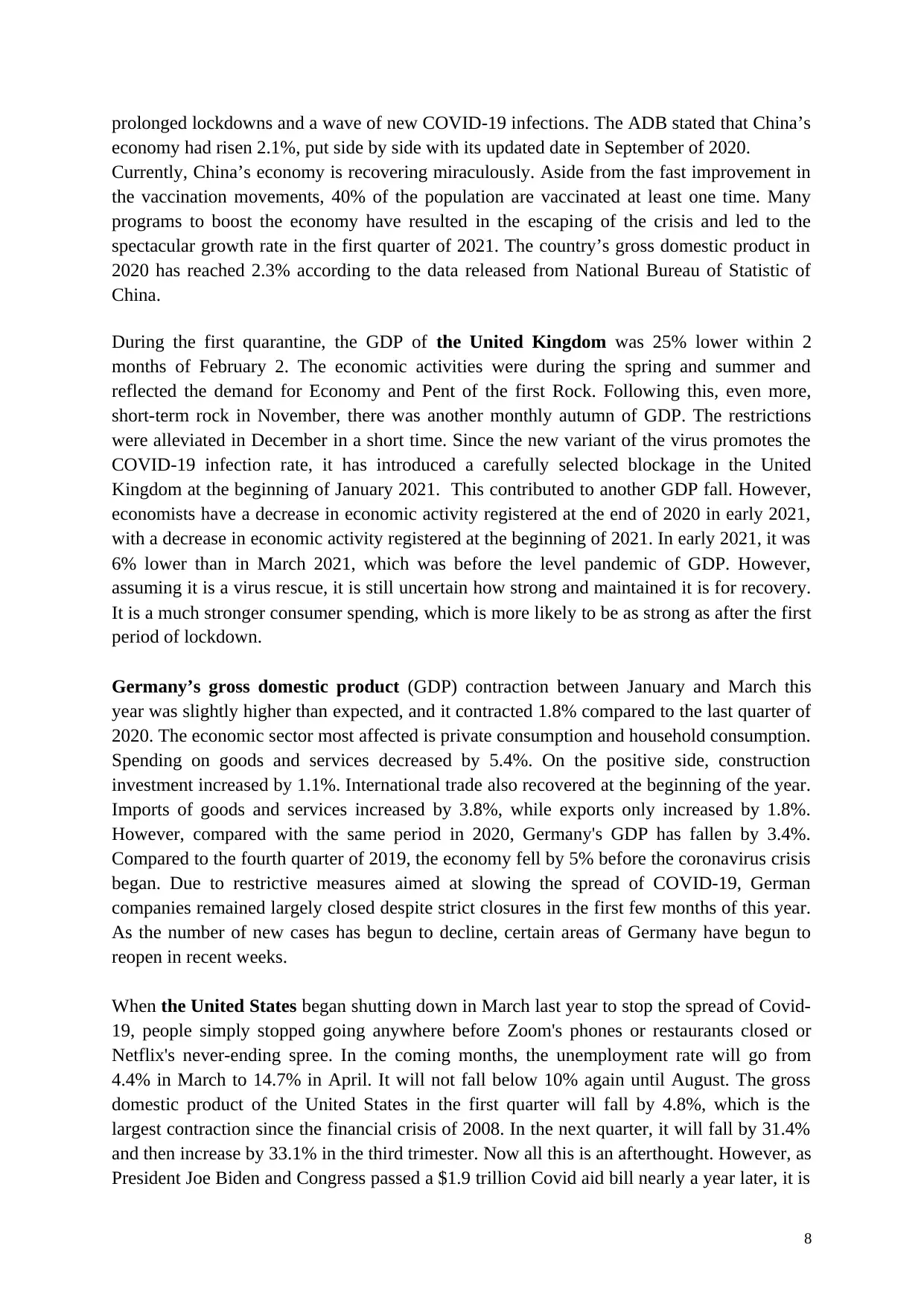
prolonged lockdowns and a wave of new COVID-19 infections. The ADB stated that China’s
economy had risen 2.1%, put side by side with its updated date in September of 2020.
Currently, China’s economy is recovering miraculously. Aside from the fast improvement in
the vaccination movements, 40% of the population are vaccinated at least one time. Many
programs to boost the economy have resulted in the escaping of the crisis and led to the
spectacular growth rate in the first quarter of 2021. The country’s gross domestic product in
2020 has reached 2.3% according to the data released from National Bureau of Statistic of
China.
During the first quarantine, the GDP of the United Kingdom was 25% lower within 2
months of February 2. The economic activities were during the spring and summer and
reflected the demand for Economy and Pent of the first Rock. Following this, even more,
short-term rock in November, there was another monthly autumn of GDP. The restrictions
were alleviated in December in a short time. Since the new variant of the virus promotes the
COVID-19 infection rate, it has introduced a carefully selected blockage in the United
Kingdom at the beginning of January 2021. This contributed to another GDP fall. However,
economists have a decrease in economic activity registered at the end of 2020 in early 2021,
with a decrease in economic activity registered at the beginning of 2021. In early 2021, it was
6% lower than in March 2021, which was before the level pandemic of GDP. However,
assuming it is a virus rescue, it is still uncertain how strong and maintained it is for recovery.
It is a much stronger consumer spending, which is more likely to be as strong as after the first
period of lockdown.
Germany’s gross domestic product (GDP) contraction between January and March this
year was slightly higher than expected, and it contracted 1.8% compared to the last quarter of
2020. The economic sector most affected is private consumption and household consumption.
Spending on goods and services decreased by 5.4%. On the positive side, construction
investment increased by 1.1%. International trade also recovered at the beginning of the year.
Imports of goods and services increased by 3.8%, while exports only increased by 1.8%.
However, compared with the same period in 2020, Germany's GDP has fallen by 3.4%.
Compared to the fourth quarter of 2019, the economy fell by 5% before the coronavirus crisis
began. Due to restrictive measures aimed at slowing the spread of COVID-19, German
companies remained largely closed despite strict closures in the first few months of this year.
As the number of new cases has begun to decline, certain areas of Germany have begun to
reopen in recent weeks.
When the United States began shutting down in March last year to stop the spread of Covid-
19, people simply stopped going anywhere before Zoom's phones or restaurants closed or
Netflix's never-ending spree. In the coming months, the unemployment rate will go from
4.4% in March to 14.7% in April. It will not fall below 10% again until August. The gross
domestic product of the United States in the first quarter will fall by 4.8%, which is the
largest contraction since the financial crisis of 2008. In the next quarter, it will fall by 31.4%
and then increase by 33.1% in the third trimester. Now all this is an afterthought. However, as
President Joe Biden and Congress passed a $1.9 trillion Covid aid bill nearly a year later, it is
8
economy had risen 2.1%, put side by side with its updated date in September of 2020.
Currently, China’s economy is recovering miraculously. Aside from the fast improvement in
the vaccination movements, 40% of the population are vaccinated at least one time. Many
programs to boost the economy have resulted in the escaping of the crisis and led to the
spectacular growth rate in the first quarter of 2021. The country’s gross domestic product in
2020 has reached 2.3% according to the data released from National Bureau of Statistic of
China.
During the first quarantine, the GDP of the United Kingdom was 25% lower within 2
months of February 2. The economic activities were during the spring and summer and
reflected the demand for Economy and Pent of the first Rock. Following this, even more,
short-term rock in November, there was another monthly autumn of GDP. The restrictions
were alleviated in December in a short time. Since the new variant of the virus promotes the
COVID-19 infection rate, it has introduced a carefully selected blockage in the United
Kingdom at the beginning of January 2021. This contributed to another GDP fall. However,
economists have a decrease in economic activity registered at the end of 2020 in early 2021,
with a decrease in economic activity registered at the beginning of 2021. In early 2021, it was
6% lower than in March 2021, which was before the level pandemic of GDP. However,
assuming it is a virus rescue, it is still uncertain how strong and maintained it is for recovery.
It is a much stronger consumer spending, which is more likely to be as strong as after the first
period of lockdown.
Germany’s gross domestic product (GDP) contraction between January and March this
year was slightly higher than expected, and it contracted 1.8% compared to the last quarter of
2020. The economic sector most affected is private consumption and household consumption.
Spending on goods and services decreased by 5.4%. On the positive side, construction
investment increased by 1.1%. International trade also recovered at the beginning of the year.
Imports of goods and services increased by 3.8%, while exports only increased by 1.8%.
However, compared with the same period in 2020, Germany's GDP has fallen by 3.4%.
Compared to the fourth quarter of 2019, the economy fell by 5% before the coronavirus crisis
began. Due to restrictive measures aimed at slowing the spread of COVID-19, German
companies remained largely closed despite strict closures in the first few months of this year.
As the number of new cases has begun to decline, certain areas of Germany have begun to
reopen in recent weeks.
When the United States began shutting down in March last year to stop the spread of Covid-
19, people simply stopped going anywhere before Zoom's phones or restaurants closed or
Netflix's never-ending spree. In the coming months, the unemployment rate will go from
4.4% in March to 14.7% in April. It will not fall below 10% again until August. The gross
domestic product of the United States in the first quarter will fall by 4.8%, which is the
largest contraction since the financial crisis of 2008. In the next quarter, it will fall by 31.4%
and then increase by 33.1% in the third trimester. Now all this is an afterthought. However, as
President Joe Biden and Congress passed a $1.9 trillion Covid aid bill nearly a year later, it is
8
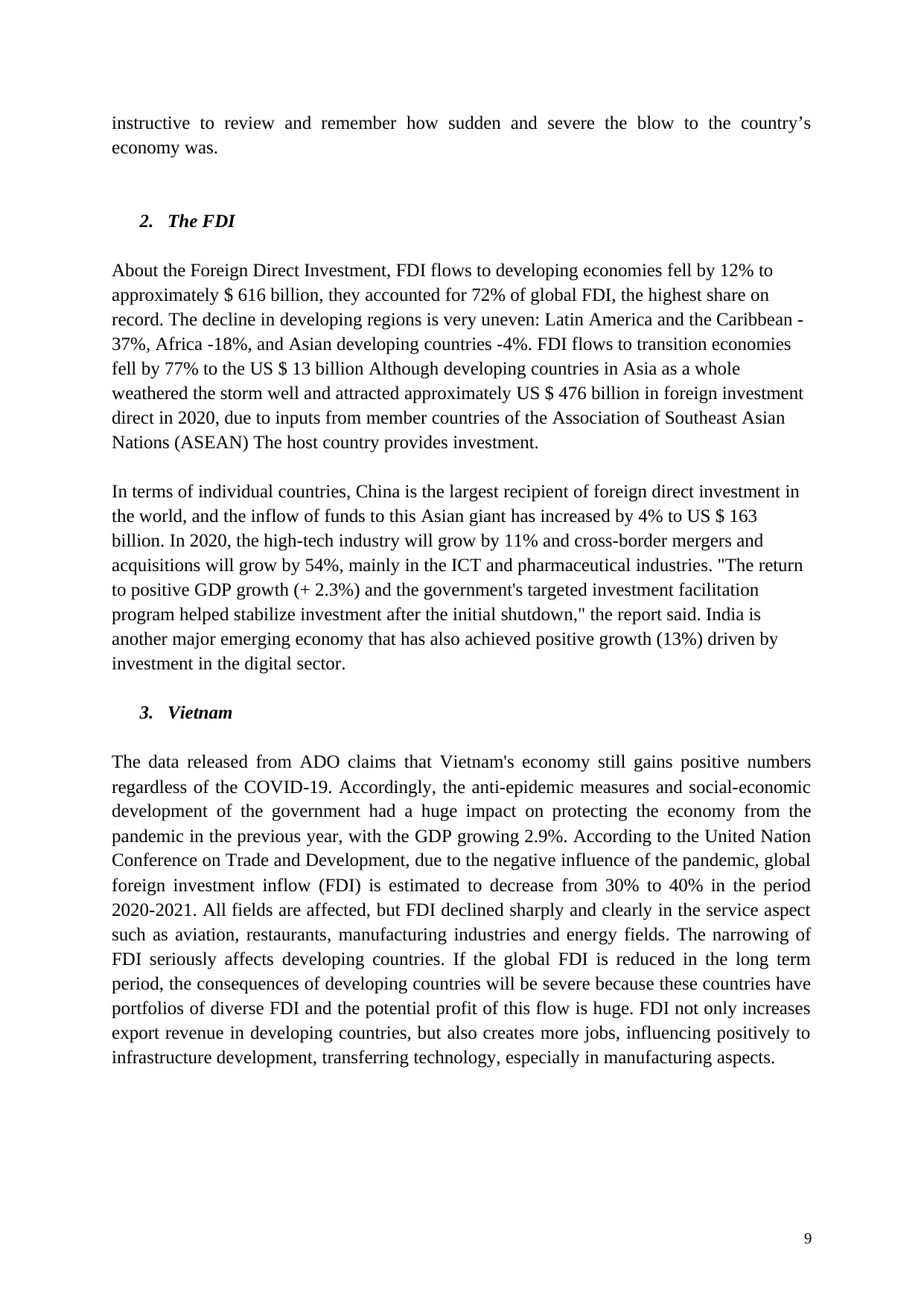
instructive to review and remember how sudden and severe the blow to the country’s
economy was.
2. The FDI
About the Foreign Direct Investment, FDI flows to developing economies fell by 12% to
approximately $ 616 billion, they accounted for 72% of global FDI, the highest share on
record. The decline in developing regions is very uneven: Latin America and the Caribbean -
37%, Africa -18%, and Asian developing countries -4%. FDI flows to transition economies
fell by 77% to the US $ 13 billion Although developing countries in Asia as a whole
weathered the storm well and attracted approximately US $ 476 billion in foreign investment
direct in 2020, due to inputs from member countries of the Association of Southeast Asian
Nations (ASEAN) The host country provides investment.
In terms of individual countries, China is the largest recipient of foreign direct investment in
the world, and the inflow of funds to this Asian giant has increased by 4% to US $ 163
billion. In 2020, the high-tech industry will grow by 11% and cross-border mergers and
acquisitions will grow by 54%, mainly in the ICT and pharmaceutical industries. "The return
to positive GDP growth (+ 2.3%) and the government's targeted investment facilitation
program helped stabilize investment after the initial shutdown," the report said. India is
another major emerging economy that has also achieved positive growth (13%) driven by
investment in the digital sector.
3. Vietnam
The data released from ADO claims that Vietnam's economy still gains positive numbers
regardless of the COVID-19. Accordingly, the anti-epidemic measures and social-economic
development of the government had a huge impact on protecting the economy from the
pandemic in the previous year, with the GDP growing 2.9%. According to the United Nation
Conference on Trade and Development, due to the negative influence of the pandemic, global
foreign investment inflow (FDI) is estimated to decrease from 30% to 40% in the period
2020-2021. All fields are affected, but FDI declined sharply and clearly in the service aspect
such as aviation, restaurants, manufacturing industries and energy fields. The narrowing of
FDI seriously affects developing countries. If the global FDI is reduced in the long term
period, the consequences of developing countries will be severe because these countries have
portfolios of diverse FDI and the potential profit of this flow is huge. FDI not only increases
export revenue in developing countries, but also creates more jobs, influencing positively to
infrastructure development, transferring technology, especially in manufacturing aspects.
9
economy was.
2. The FDI
About the Foreign Direct Investment, FDI flows to developing economies fell by 12% to
approximately $ 616 billion, they accounted for 72% of global FDI, the highest share on
record. The decline in developing regions is very uneven: Latin America and the Caribbean -
37%, Africa -18%, and Asian developing countries -4%. FDI flows to transition economies
fell by 77% to the US $ 13 billion Although developing countries in Asia as a whole
weathered the storm well and attracted approximately US $ 476 billion in foreign investment
direct in 2020, due to inputs from member countries of the Association of Southeast Asian
Nations (ASEAN) The host country provides investment.
In terms of individual countries, China is the largest recipient of foreign direct investment in
the world, and the inflow of funds to this Asian giant has increased by 4% to US $ 163
billion. In 2020, the high-tech industry will grow by 11% and cross-border mergers and
acquisitions will grow by 54%, mainly in the ICT and pharmaceutical industries. "The return
to positive GDP growth (+ 2.3%) and the government's targeted investment facilitation
program helped stabilize investment after the initial shutdown," the report said. India is
another major emerging economy that has also achieved positive growth (13%) driven by
investment in the digital sector.
3. Vietnam
The data released from ADO claims that Vietnam's economy still gains positive numbers
regardless of the COVID-19. Accordingly, the anti-epidemic measures and social-economic
development of the government had a huge impact on protecting the economy from the
pandemic in the previous year, with the GDP growing 2.9%. According to the United Nation
Conference on Trade and Development, due to the negative influence of the pandemic, global
foreign investment inflow (FDI) is estimated to decrease from 30% to 40% in the period
2020-2021. All fields are affected, but FDI declined sharply and clearly in the service aspect
such as aviation, restaurants, manufacturing industries and energy fields. The narrowing of
FDI seriously affects developing countries. If the global FDI is reduced in the long term
period, the consequences of developing countries will be severe because these countries have
portfolios of diverse FDI and the potential profit of this flow is huge. FDI not only increases
export revenue in developing countries, but also creates more jobs, influencing positively to
infrastructure development, transferring technology, especially in manufacturing aspects.
9
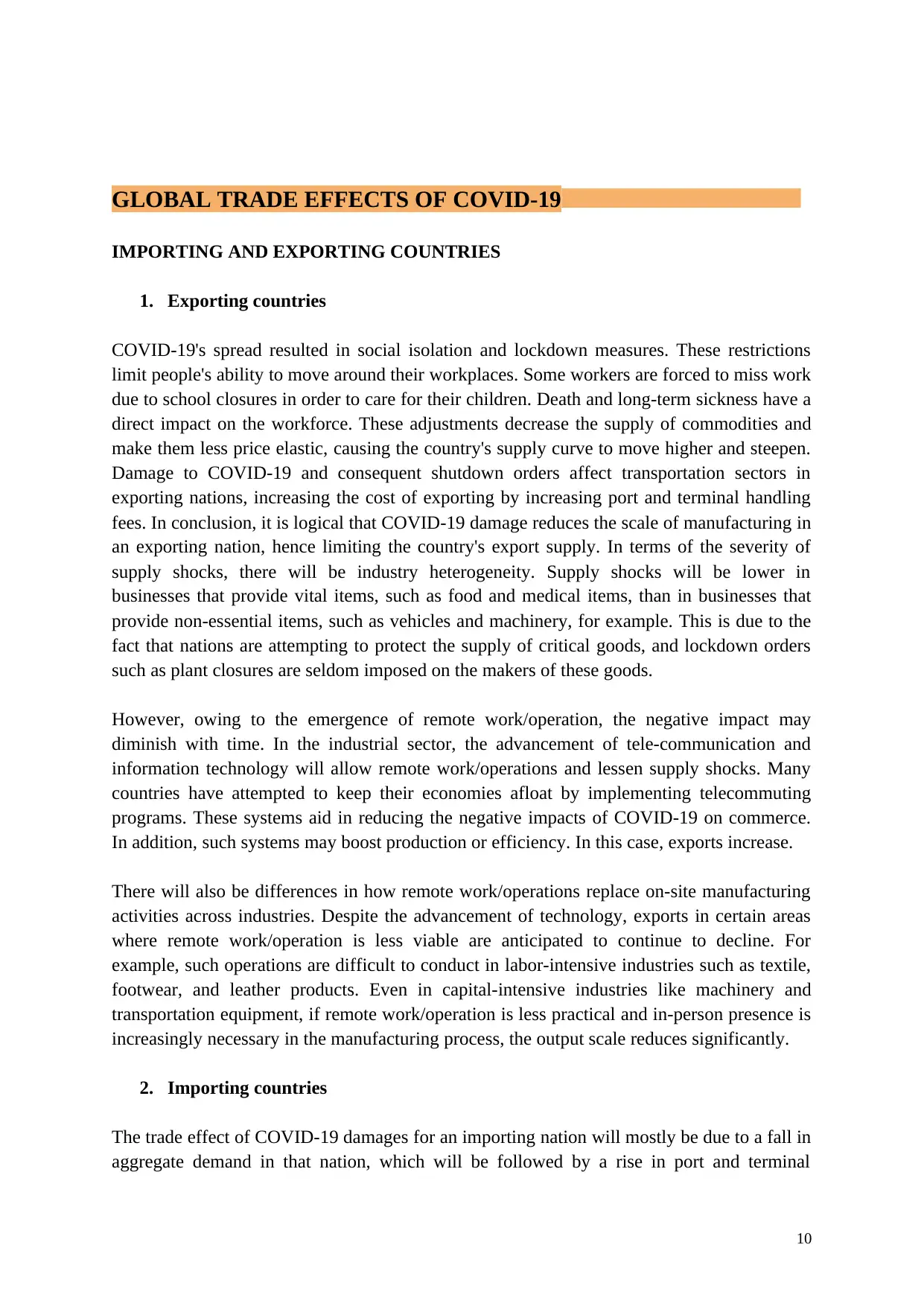
GLOBAL TRADE EFFECTS OF COVID-19
IMPORTING AND EXPORTING COUNTRIES
1. Exporting countries
COVID-19's spread resulted in social isolation and lockdown measures. These restrictions
limit people's ability to move around their workplaces. Some workers are forced to miss work
due to school closures in order to care for their children. Death and long-term sickness have a
direct impact on the workforce. These adjustments decrease the supply of commodities and
make them less price elastic, causing the country's supply curve to move higher and steepen.
Damage to COVID-19 and consequent shutdown orders affect transportation sectors in
exporting nations, increasing the cost of exporting by increasing port and terminal handling
fees. In conclusion, it is logical that COVID-19 damage reduces the scale of manufacturing in
an exporting nation, hence limiting the country's export supply. In terms of the severity of
supply shocks, there will be industry heterogeneity. Supply shocks will be lower in
businesses that provide vital items, such as food and medical items, than in businesses that
provide non-essential items, such as vehicles and machinery, for example. This is due to the
fact that nations are attempting to protect the supply of critical goods, and lockdown orders
such as plant closures are seldom imposed on the makers of these goods.
However, owing to the emergence of remote work/operation, the negative impact may
diminish with time. In the industrial sector, the advancement of tele-communication and
information technology will allow remote work/operations and lessen supply shocks. Many
countries have attempted to keep their economies afloat by implementing telecommuting
programs. These systems aid in reducing the negative impacts of COVID-19 on commerce.
In addition, such systems may boost production or efficiency. In this case, exports increase.
There will also be differences in how remote work/operations replace on-site manufacturing
activities across industries. Despite the advancement of technology, exports in certain areas
where remote work/operation is less viable are anticipated to continue to decline. For
example, such operations are difficult to conduct in labor-intensive industries such as textile,
footwear, and leather products. Even in capital-intensive industries like machinery and
transportation equipment, if remote work/operation is less practical and in-person presence is
increasingly necessary in the manufacturing process, the output scale reduces significantly.
2. Importing countries
The trade effect of COVID-19 damages for an importing nation will mostly be due to a fall in
aggregate demand in that nation, which will be followed by a rise in port and terminal
10
IMPORTING AND EXPORTING COUNTRIES
1. Exporting countries
COVID-19's spread resulted in social isolation and lockdown measures. These restrictions
limit people's ability to move around their workplaces. Some workers are forced to miss work
due to school closures in order to care for their children. Death and long-term sickness have a
direct impact on the workforce. These adjustments decrease the supply of commodities and
make them less price elastic, causing the country's supply curve to move higher and steepen.
Damage to COVID-19 and consequent shutdown orders affect transportation sectors in
exporting nations, increasing the cost of exporting by increasing port and terminal handling
fees. In conclusion, it is logical that COVID-19 damage reduces the scale of manufacturing in
an exporting nation, hence limiting the country's export supply. In terms of the severity of
supply shocks, there will be industry heterogeneity. Supply shocks will be lower in
businesses that provide vital items, such as food and medical items, than in businesses that
provide non-essential items, such as vehicles and machinery, for example. This is due to the
fact that nations are attempting to protect the supply of critical goods, and lockdown orders
such as plant closures are seldom imposed on the makers of these goods.
However, owing to the emergence of remote work/operation, the negative impact may
diminish with time. In the industrial sector, the advancement of tele-communication and
information technology will allow remote work/operations and lessen supply shocks. Many
countries have attempted to keep their economies afloat by implementing telecommuting
programs. These systems aid in reducing the negative impacts of COVID-19 on commerce.
In addition, such systems may boost production or efficiency. In this case, exports increase.
There will also be differences in how remote work/operations replace on-site manufacturing
activities across industries. Despite the advancement of technology, exports in certain areas
where remote work/operation is less viable are anticipated to continue to decline. For
example, such operations are difficult to conduct in labor-intensive industries such as textile,
footwear, and leather products. Even in capital-intensive industries like machinery and
transportation equipment, if remote work/operation is less practical and in-person presence is
increasingly necessary in the manufacturing process, the output scale reduces significantly.
2. Importing countries
The trade effect of COVID-19 damages for an importing nation will mostly be due to a fall in
aggregate demand in that nation, which will be followed by a rise in port and terminal
10
Secure Best Marks with AI Grader
Need help grading? Try our AI Grader for instant feedback on your assignments.
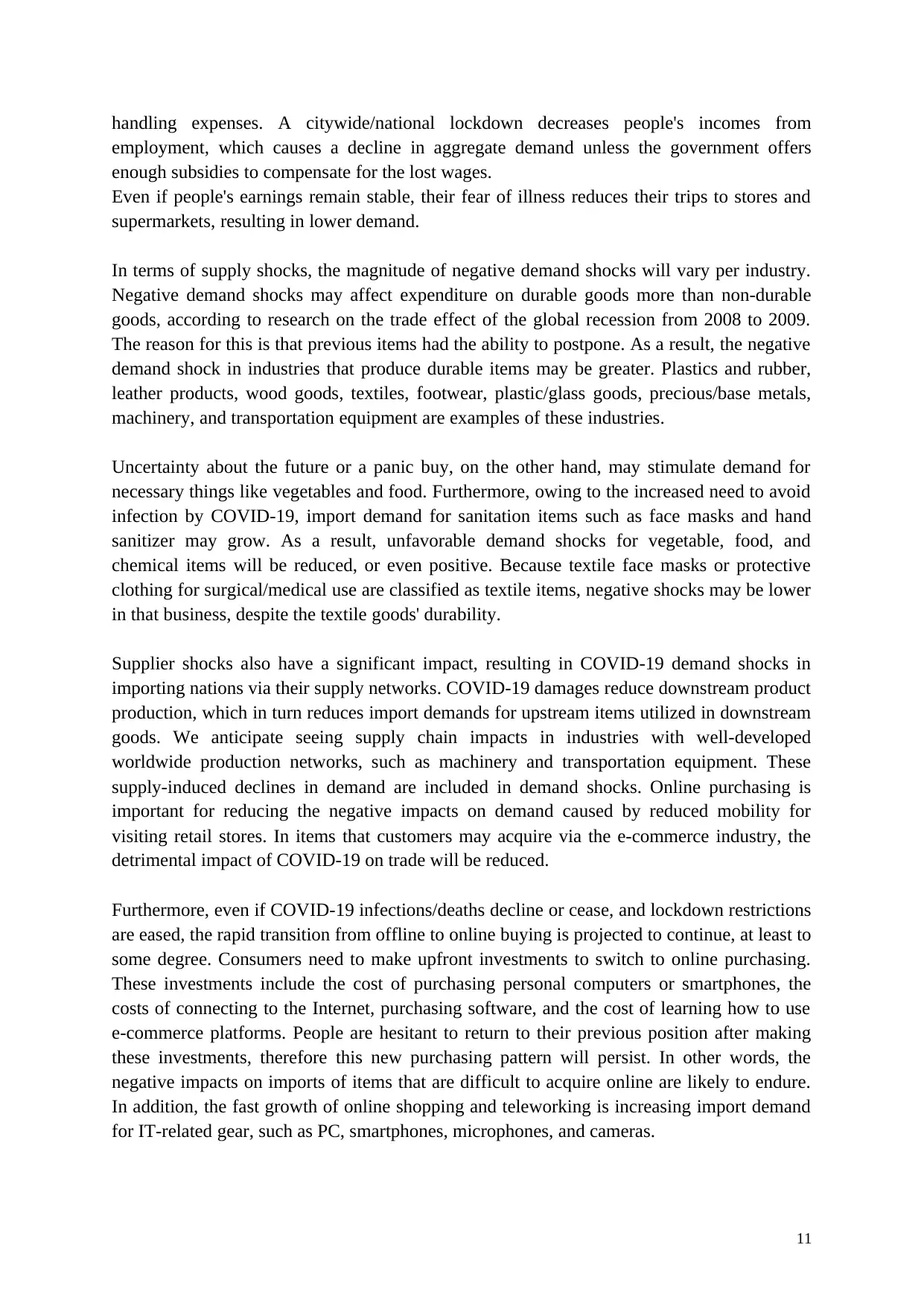
handling expenses. A citywide/national lockdown decreases people's incomes from
employment, which causes a decline in aggregate demand unless the government offers
enough subsidies to compensate for the lost wages.
Even if people's earnings remain stable, their fear of illness reduces their trips to stores and
supermarkets, resulting in lower demand.
In terms of supply shocks, the magnitude of negative demand shocks will vary per industry.
Negative demand shocks may affect expenditure on durable goods more than non-durable
goods, according to research on the trade effect of the global recession from 2008 to 2009.
The reason for this is that previous items had the ability to postpone. As a result, the negative
demand shock in industries that produce durable items may be greater. Plastics and rubber,
leather products, wood goods, textiles, footwear, plastic/glass goods, precious/base metals,
machinery, and transportation equipment are examples of these industries.
Uncertainty about the future or a panic buy, on the other hand, may stimulate demand for
necessary things like vegetables and food. Furthermore, owing to the increased need to avoid
infection by COVID-19, import demand for sanitation items such as face masks and hand
sanitizer may grow. As a result, unfavorable demand shocks for vegetable, food, and
chemical items will be reduced, or even positive. Because textile face masks or protective
clothing for surgical/medical use are classified as textile items, negative shocks may be lower
in that business, despite the textile goods' durability.
Supplier shocks also have a significant impact, resulting in COVID-19 demand shocks in
importing nations via their supply networks. COVID-19 damages reduce downstream product
production, which in turn reduces import demands for upstream items utilized in downstream
goods. We anticipate seeing supply chain impacts in industries with well-developed
worldwide production networks, such as machinery and transportation equipment. These
supply-induced declines in demand are included in demand shocks. Online purchasing is
important for reducing the negative impacts on demand caused by reduced mobility for
visiting retail stores. In items that customers may acquire via the e-commerce industry, the
detrimental impact of COVID-19 on trade will be reduced.
Furthermore, even if COVID-19 infections/deaths decline or cease, and lockdown restrictions
are eased, the rapid transition from offline to online buying is projected to continue, at least to
some degree. Consumers need to make upfront investments to switch to online purchasing.
These investments include the cost of purchasing personal computers or smartphones, the
costs of connecting to the Internet, purchasing software, and the cost of learning how to use
e-commerce platforms. People are hesitant to return to their previous position after making
these investments, therefore this new purchasing pattern will persist. In other words, the
negative impacts on imports of items that are difficult to acquire online are likely to endure.
In addition, the fast growth of online shopping and teleworking is increasing import demand
for IT-related gear, such as PC, smartphones, microphones, and cameras.
11
employment, which causes a decline in aggregate demand unless the government offers
enough subsidies to compensate for the lost wages.
Even if people's earnings remain stable, their fear of illness reduces their trips to stores and
supermarkets, resulting in lower demand.
In terms of supply shocks, the magnitude of negative demand shocks will vary per industry.
Negative demand shocks may affect expenditure on durable goods more than non-durable
goods, according to research on the trade effect of the global recession from 2008 to 2009.
The reason for this is that previous items had the ability to postpone. As a result, the negative
demand shock in industries that produce durable items may be greater. Plastics and rubber,
leather products, wood goods, textiles, footwear, plastic/glass goods, precious/base metals,
machinery, and transportation equipment are examples of these industries.
Uncertainty about the future or a panic buy, on the other hand, may stimulate demand for
necessary things like vegetables and food. Furthermore, owing to the increased need to avoid
infection by COVID-19, import demand for sanitation items such as face masks and hand
sanitizer may grow. As a result, unfavorable demand shocks for vegetable, food, and
chemical items will be reduced, or even positive. Because textile face masks or protective
clothing for surgical/medical use are classified as textile items, negative shocks may be lower
in that business, despite the textile goods' durability.
Supplier shocks also have a significant impact, resulting in COVID-19 demand shocks in
importing nations via their supply networks. COVID-19 damages reduce downstream product
production, which in turn reduces import demands for upstream items utilized in downstream
goods. We anticipate seeing supply chain impacts in industries with well-developed
worldwide production networks, such as machinery and transportation equipment. These
supply-induced declines in demand are included in demand shocks. Online purchasing is
important for reducing the negative impacts on demand caused by reduced mobility for
visiting retail stores. In items that customers may acquire via the e-commerce industry, the
detrimental impact of COVID-19 on trade will be reduced.
Furthermore, even if COVID-19 infections/deaths decline or cease, and lockdown restrictions
are eased, the rapid transition from offline to online buying is projected to continue, at least to
some degree. Consumers need to make upfront investments to switch to online purchasing.
These investments include the cost of purchasing personal computers or smartphones, the
costs of connecting to the Internet, purchasing software, and the cost of learning how to use
e-commerce platforms. People are hesitant to return to their previous position after making
these investments, therefore this new purchasing pattern will persist. In other words, the
negative impacts on imports of items that are difficult to acquire online are likely to endure.
In addition, the fast growth of online shopping and teleworking is increasing import demand
for IT-related gear, such as PC, smartphones, microphones, and cameras.
11
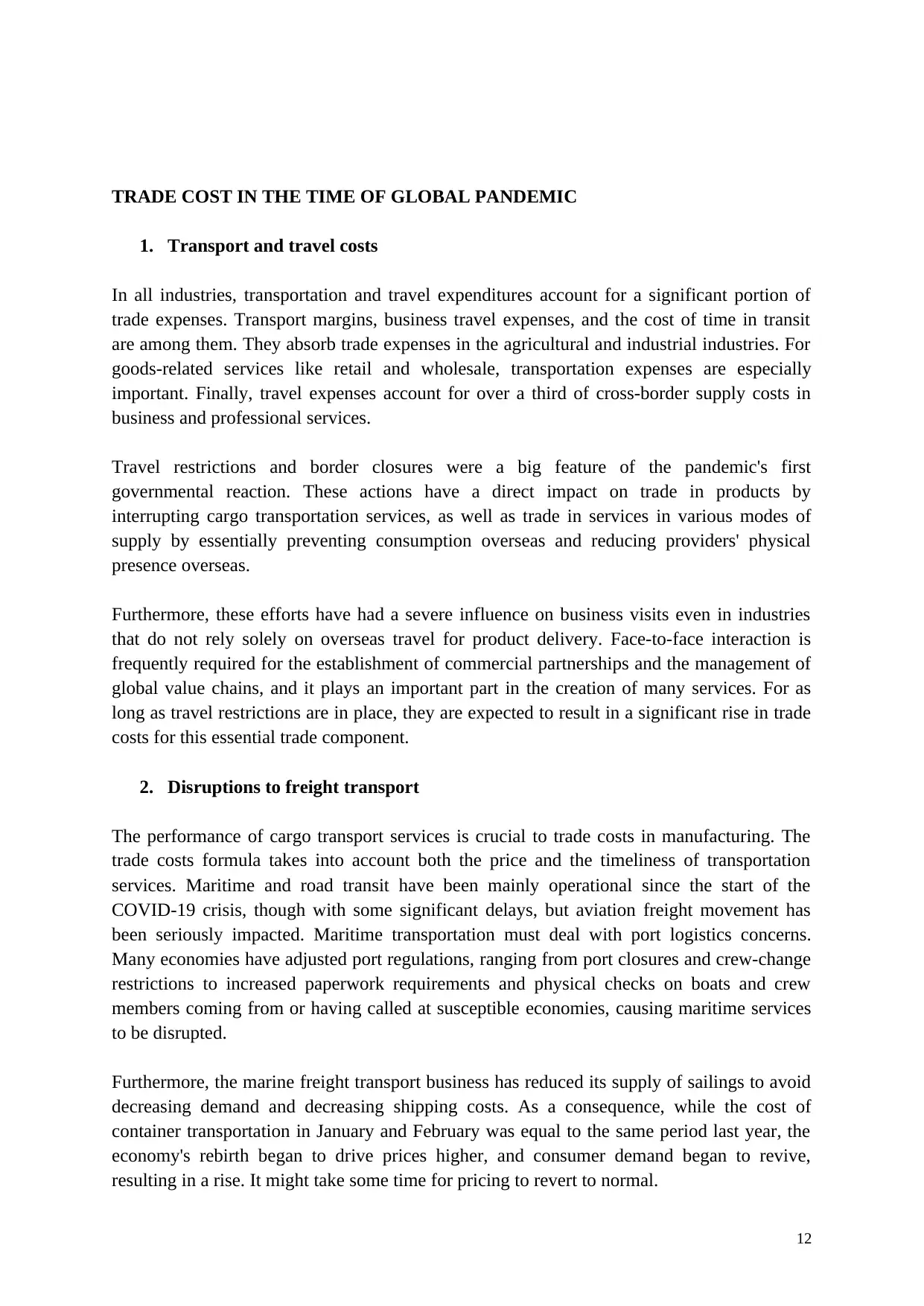
TRADE COST IN THE TIME OF GLOBAL PANDEMIC
1. Transport and travel costs
In all industries, transportation and travel expenditures account for a significant portion of
trade expenses. Transport margins, business travel expenses, and the cost of time in transit
are among them. They absorb trade expenses in the agricultural and industrial industries. For
goods-related services like retail and wholesale, transportation expenses are especially
important. Finally, travel expenses account for over a third of cross-border supply costs in
business and professional services.
Travel restrictions and border closures were a big feature of the pandemic's first
governmental reaction. These actions have a direct impact on trade in products by
interrupting cargo transportation services, as well as trade in services in various modes of
supply by essentially preventing consumption overseas and reducing providers' physical
presence overseas.
Furthermore, these efforts have had a severe influence on business visits even in industries
that do not rely solely on overseas travel for product delivery. Face-to-face interaction is
frequently required for the establishment of commercial partnerships and the management of
global value chains, and it plays an important part in the creation of many services. For as
long as travel restrictions are in place, they are expected to result in a significant rise in trade
costs for this essential trade component.
2. Disruptions to freight transport
The performance of cargo transport services is crucial to trade costs in manufacturing. The
trade costs formula takes into account both the price and the timeliness of transportation
services. Maritime and road transit have been mainly operational since the start of the
COVID-19 crisis, though with some significant delays, but aviation freight movement has
been seriously impacted. Maritime transportation must deal with port logistics concerns.
Many economies have adjusted port regulations, ranging from port closures and crew-change
restrictions to increased paperwork requirements and physical checks on boats and crew
members coming from or having called at susceptible economies, causing maritime services
to be disrupted.
Furthermore, the marine freight transport business has reduced its supply of sailings to avoid
decreasing demand and decreasing shipping costs. As a consequence, while the cost of
container transportation in January and February was equal to the same period last year, the
economy's rebirth began to drive prices higher, and consumer demand began to revive,
resulting in a rise. It might take some time for pricing to revert to normal.
12
1. Transport and travel costs
In all industries, transportation and travel expenditures account for a significant portion of
trade expenses. Transport margins, business travel expenses, and the cost of time in transit
are among them. They absorb trade expenses in the agricultural and industrial industries. For
goods-related services like retail and wholesale, transportation expenses are especially
important. Finally, travel expenses account for over a third of cross-border supply costs in
business and professional services.
Travel restrictions and border closures were a big feature of the pandemic's first
governmental reaction. These actions have a direct impact on trade in products by
interrupting cargo transportation services, as well as trade in services in various modes of
supply by essentially preventing consumption overseas and reducing providers' physical
presence overseas.
Furthermore, these efforts have had a severe influence on business visits even in industries
that do not rely solely on overseas travel for product delivery. Face-to-face interaction is
frequently required for the establishment of commercial partnerships and the management of
global value chains, and it plays an important part in the creation of many services. For as
long as travel restrictions are in place, they are expected to result in a significant rise in trade
costs for this essential trade component.
2. Disruptions to freight transport
The performance of cargo transport services is crucial to trade costs in manufacturing. The
trade costs formula takes into account both the price and the timeliness of transportation
services. Maritime and road transit have been mainly operational since the start of the
COVID-19 crisis, though with some significant delays, but aviation freight movement has
been seriously impacted. Maritime transportation must deal with port logistics concerns.
Many economies have adjusted port regulations, ranging from port closures and crew-change
restrictions to increased paperwork requirements and physical checks on boats and crew
members coming from or having called at susceptible economies, causing maritime services
to be disrupted.
Furthermore, the marine freight transport business has reduced its supply of sailings to avoid
decreasing demand and decreasing shipping costs. As a consequence, while the cost of
container transportation in January and February was equal to the same period last year, the
economy's rebirth began to drive prices higher, and consumer demand began to revive,
resulting in a rise. It might take some time for pricing to revert to normal.
12
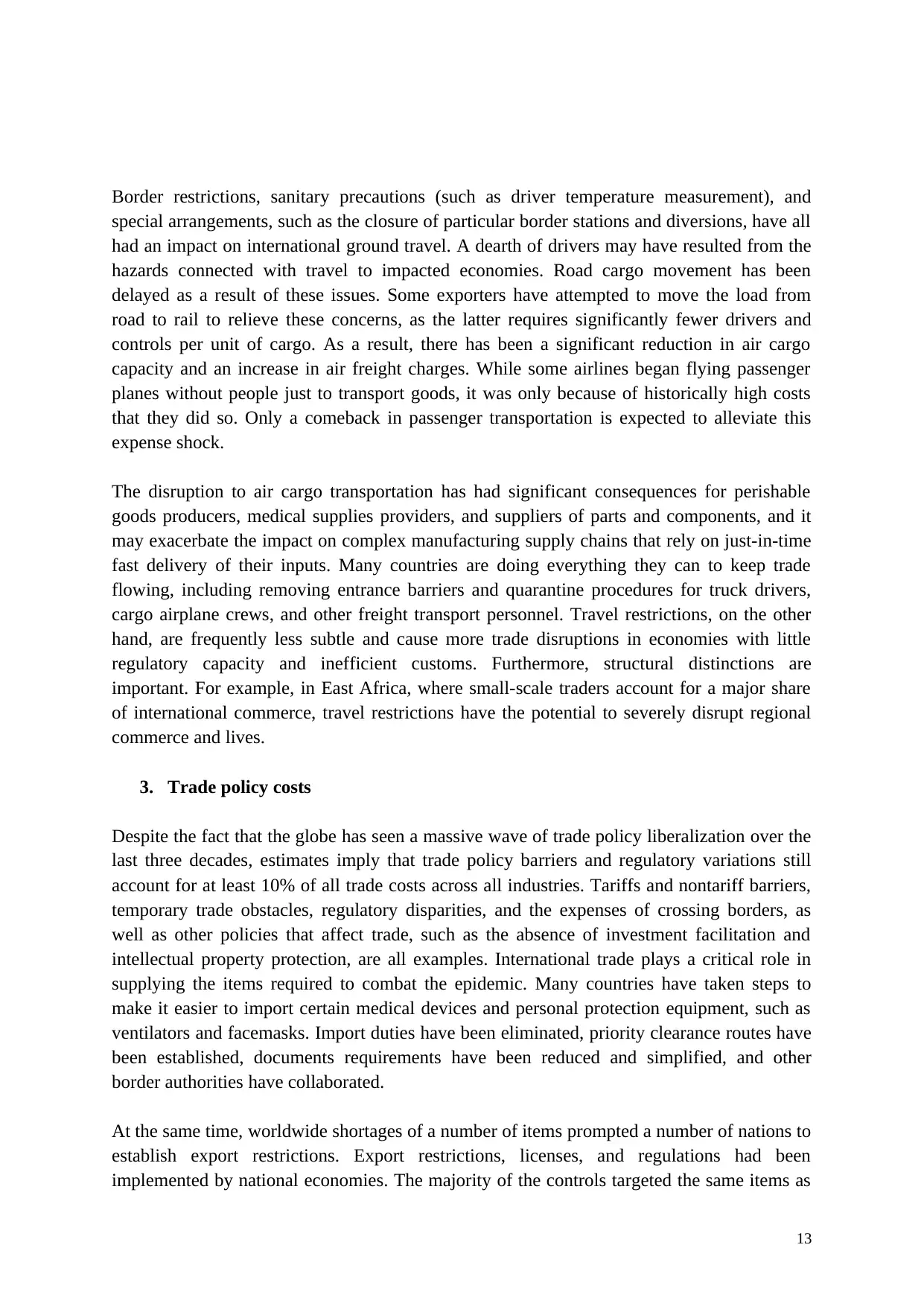
Border restrictions, sanitary precautions (such as driver temperature measurement), and
special arrangements, such as the closure of particular border stations and diversions, have all
had an impact on international ground travel. A dearth of drivers may have resulted from the
hazards connected with travel to impacted economies. Road cargo movement has been
delayed as a result of these issues. Some exporters have attempted to move the load from
road to rail to relieve these concerns, as the latter requires significantly fewer drivers and
controls per unit of cargo. As a result, there has been a significant reduction in air cargo
capacity and an increase in air freight charges. While some airlines began flying passenger
planes without people just to transport goods, it was only because of historically high costs
that they did so. Only a comeback in passenger transportation is expected to alleviate this
expense shock.
The disruption to air cargo transportation has had significant consequences for perishable
goods producers, medical supplies providers, and suppliers of parts and components, and it
may exacerbate the impact on complex manufacturing supply chains that rely on just-in-time
fast delivery of their inputs. Many countries are doing everything they can to keep trade
flowing, including removing entrance barriers and quarantine procedures for truck drivers,
cargo airplane crews, and other freight transport personnel. Travel restrictions, on the other
hand, are frequently less subtle and cause more trade disruptions in economies with little
regulatory capacity and inefficient customs. Furthermore, structural distinctions are
important. For example, in East Africa, where small-scale traders account for a major share
of international commerce, travel restrictions have the potential to severely disrupt regional
commerce and lives.
3. Trade policy costs
Despite the fact that the globe has seen a massive wave of trade policy liberalization over the
last three decades, estimates imply that trade policy barriers and regulatory variations still
account for at least 10% of all trade costs across all industries. Tariffs and nontariff barriers,
temporary trade obstacles, regulatory disparities, and the expenses of crossing borders, as
well as other policies that affect trade, such as the absence of investment facilitation and
intellectual property protection, are all examples. International trade plays a critical role in
supplying the items required to combat the epidemic. Many countries have taken steps to
make it easier to import certain medical devices and personal protection equipment, such as
ventilators and facemasks. Import duties have been eliminated, priority clearance routes have
been established, documents requirements have been reduced and simplified, and other
border authorities have collaborated.
At the same time, worldwide shortages of a number of items prompted a number of nations to
establish export restrictions. Export restrictions, licenses, and regulations had been
implemented by national economies. The majority of the controls targeted the same items as
13
special arrangements, such as the closure of particular border stations and diversions, have all
had an impact on international ground travel. A dearth of drivers may have resulted from the
hazards connected with travel to impacted economies. Road cargo movement has been
delayed as a result of these issues. Some exporters have attempted to move the load from
road to rail to relieve these concerns, as the latter requires significantly fewer drivers and
controls per unit of cargo. As a result, there has been a significant reduction in air cargo
capacity and an increase in air freight charges. While some airlines began flying passenger
planes without people just to transport goods, it was only because of historically high costs
that they did so. Only a comeback in passenger transportation is expected to alleviate this
expense shock.
The disruption to air cargo transportation has had significant consequences for perishable
goods producers, medical supplies providers, and suppliers of parts and components, and it
may exacerbate the impact on complex manufacturing supply chains that rely on just-in-time
fast delivery of their inputs. Many countries are doing everything they can to keep trade
flowing, including removing entrance barriers and quarantine procedures for truck drivers,
cargo airplane crews, and other freight transport personnel. Travel restrictions, on the other
hand, are frequently less subtle and cause more trade disruptions in economies with little
regulatory capacity and inefficient customs. Furthermore, structural distinctions are
important. For example, in East Africa, where small-scale traders account for a major share
of international commerce, travel restrictions have the potential to severely disrupt regional
commerce and lives.
3. Trade policy costs
Despite the fact that the globe has seen a massive wave of trade policy liberalization over the
last three decades, estimates imply that trade policy barriers and regulatory variations still
account for at least 10% of all trade costs across all industries. Tariffs and nontariff barriers,
temporary trade obstacles, regulatory disparities, and the expenses of crossing borders, as
well as other policies that affect trade, such as the absence of investment facilitation and
intellectual property protection, are all examples. International trade plays a critical role in
supplying the items required to combat the epidemic. Many countries have taken steps to
make it easier to import certain medical devices and personal protection equipment, such as
ventilators and facemasks. Import duties have been eliminated, priority clearance routes have
been established, documents requirements have been reduced and simplified, and other
border authorities have collaborated.
At the same time, worldwide shortages of a number of items prompted a number of nations to
establish export restrictions. Export restrictions, licenses, and regulations had been
implemented by national economies. The majority of the controls targeted the same items as
13
Paraphrase This Document
Need a fresh take? Get an instant paraphrase of this document with our AI Paraphraser
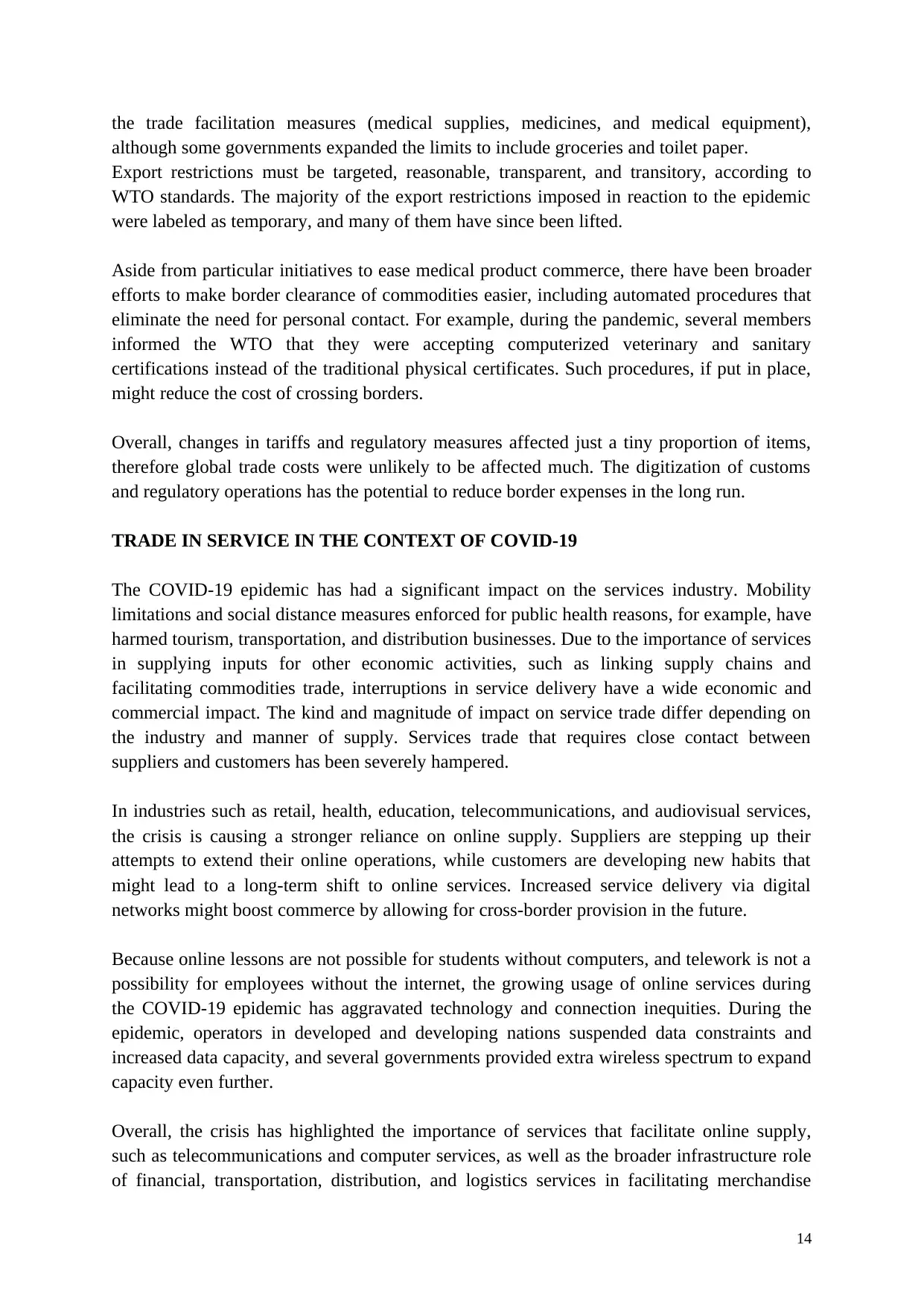
the trade facilitation measures (medical supplies, medicines, and medical equipment),
although some governments expanded the limits to include groceries and toilet paper.
Export restrictions must be targeted, reasonable, transparent, and transitory, according to
WTO standards. The majority of the export restrictions imposed in reaction to the epidemic
were labeled as temporary, and many of them have since been lifted.
Aside from particular initiatives to ease medical product commerce, there have been broader
efforts to make border clearance of commodities easier, including automated procedures that
eliminate the need for personal contact. For example, during the pandemic, several members
informed the WTO that they were accepting computerized veterinary and sanitary
certifications instead of the traditional physical certificates. Such procedures, if put in place,
might reduce the cost of crossing borders.
Overall, changes in tariffs and regulatory measures affected just a tiny proportion of items,
therefore global trade costs were unlikely to be affected much. The digitization of customs
and regulatory operations has the potential to reduce border expenses in the long run.
TRADE IN SERVICE IN THE CONTEXT OF COVID-19
The COVID-19 epidemic has had a significant impact on the services industry. Mobility
limitations and social distance measures enforced for public health reasons, for example, have
harmed tourism, transportation, and distribution businesses. Due to the importance of services
in supplying inputs for other economic activities, such as linking supply chains and
facilitating commodities trade, interruptions in service delivery have a wide economic and
commercial impact. The kind and magnitude of impact on service trade differ depending on
the industry and manner of supply. Services trade that requires close contact between
suppliers and customers has been severely hampered.
In industries such as retail, health, education, telecommunications, and audiovisual services,
the crisis is causing a stronger reliance on online supply. Suppliers are stepping up their
attempts to extend their online operations, while customers are developing new habits that
might lead to a long-term shift to online services. Increased service delivery via digital
networks might boost commerce by allowing for cross-border provision in the future.
Because online lessons are not possible for students without computers, and telework is not a
possibility for employees without the internet, the growing usage of online services during
the COVID-19 epidemic has aggravated technology and connection inequities. During the
epidemic, operators in developed and developing nations suspended data constraints and
increased data capacity, and several governments provided extra wireless spectrum to expand
capacity even further.
Overall, the crisis has highlighted the importance of services that facilitate online supply,
such as telecommunications and computer services, as well as the broader infrastructure role
of financial, transportation, distribution, and logistics services in facilitating merchandise
14
although some governments expanded the limits to include groceries and toilet paper.
Export restrictions must be targeted, reasonable, transparent, and transitory, according to
WTO standards. The majority of the export restrictions imposed in reaction to the epidemic
were labeled as temporary, and many of them have since been lifted.
Aside from particular initiatives to ease medical product commerce, there have been broader
efforts to make border clearance of commodities easier, including automated procedures that
eliminate the need for personal contact. For example, during the pandemic, several members
informed the WTO that they were accepting computerized veterinary and sanitary
certifications instead of the traditional physical certificates. Such procedures, if put in place,
might reduce the cost of crossing borders.
Overall, changes in tariffs and regulatory measures affected just a tiny proportion of items,
therefore global trade costs were unlikely to be affected much. The digitization of customs
and regulatory operations has the potential to reduce border expenses in the long run.
TRADE IN SERVICE IN THE CONTEXT OF COVID-19
The COVID-19 epidemic has had a significant impact on the services industry. Mobility
limitations and social distance measures enforced for public health reasons, for example, have
harmed tourism, transportation, and distribution businesses. Due to the importance of services
in supplying inputs for other economic activities, such as linking supply chains and
facilitating commodities trade, interruptions in service delivery have a wide economic and
commercial impact. The kind and magnitude of impact on service trade differ depending on
the industry and manner of supply. Services trade that requires close contact between
suppliers and customers has been severely hampered.
In industries such as retail, health, education, telecommunications, and audiovisual services,
the crisis is causing a stronger reliance on online supply. Suppliers are stepping up their
attempts to extend their online operations, while customers are developing new habits that
might lead to a long-term shift to online services. Increased service delivery via digital
networks might boost commerce by allowing for cross-border provision in the future.
Because online lessons are not possible for students without computers, and telework is not a
possibility for employees without the internet, the growing usage of online services during
the COVID-19 epidemic has aggravated technology and connection inequities. During the
epidemic, operators in developed and developing nations suspended data constraints and
increased data capacity, and several governments provided extra wireless spectrum to expand
capacity even further.
Overall, the crisis has highlighted the importance of services that facilitate online supply,
such as telecommunications and computer services, as well as the broader infrastructure role
of financial, transportation, distribution, and logistics services in facilitating merchandise
14
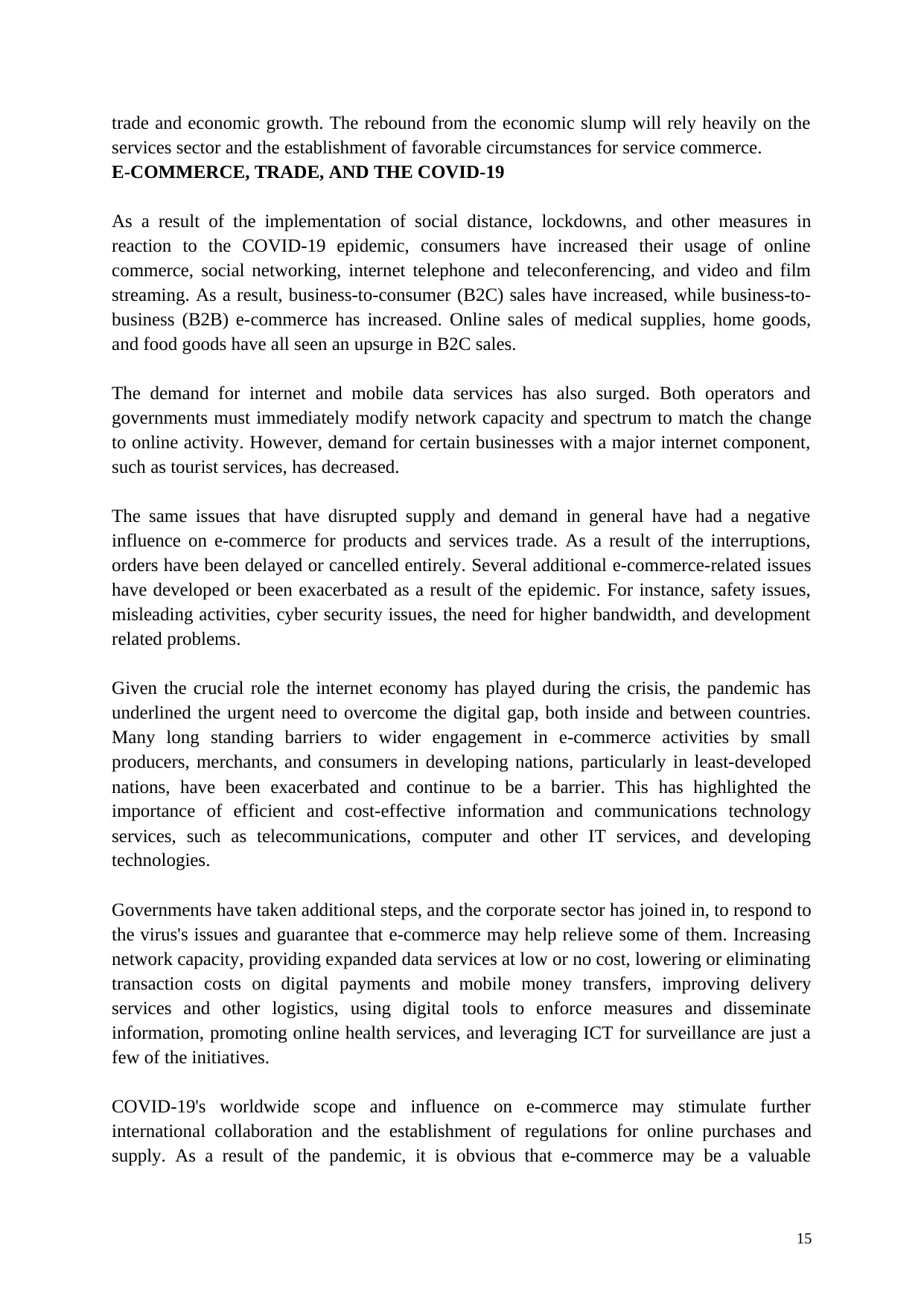
trade and economic growth. The rebound from the economic slump will rely heavily on the
services sector and the establishment of favorable circumstances for service commerce.
E-COMMERCE, TRADE, AND THE COVID-19
As a result of the implementation of social distance, lockdowns, and other measures in
reaction to the COVID-19 epidemic, consumers have increased their usage of online
commerce, social networking, internet telephone and teleconferencing, and video and film
streaming. As a result, business-to-consumer (B2C) sales have increased, while business-to-
business (B2B) e-commerce has increased. Online sales of medical supplies, home goods,
and food goods have all seen an upsurge in B2C sales.
The demand for internet and mobile data services has also surged. Both operators and
governments must immediately modify network capacity and spectrum to match the change
to online activity. However, demand for certain businesses with a major internet component,
such as tourist services, has decreased.
The same issues that have disrupted supply and demand in general have had a negative
influence on e-commerce for products and services trade. As a result of the interruptions,
orders have been delayed or cancelled entirely. Several additional e-commerce-related issues
have developed or been exacerbated as a result of the epidemic. For instance, safety issues,
misleading activities, cyber security issues, the need for higher bandwidth, and development
related problems.
Given the crucial role the internet economy has played during the crisis, the pandemic has
underlined the urgent need to overcome the digital gap, both inside and between countries.
Many long standing barriers to wider engagement in e-commerce activities by small
producers, merchants, and consumers in developing nations, particularly in least-developed
nations, have been exacerbated and continue to be a barrier. This has highlighted the
importance of efficient and cost-effective information and communications technology
services, such as telecommunications, computer and other IT services, and developing
technologies.
Governments have taken additional steps, and the corporate sector has joined in, to respond to
the virus's issues and guarantee that e-commerce may help relieve some of them. Increasing
network capacity, providing expanded data services at low or no cost, lowering or eliminating
transaction costs on digital payments and mobile money transfers, improving delivery
services and other logistics, using digital tools to enforce measures and disseminate
information, promoting online health services, and leveraging ICT for surveillance are just a
few of the initiatives.
COVID-19's worldwide scope and influence on e-commerce may stimulate further
international collaboration and the establishment of regulations for online purchases and
supply. As a result of the pandemic, it is obvious that e-commerce may be a valuable
15
services sector and the establishment of favorable circumstances for service commerce.
E-COMMERCE, TRADE, AND THE COVID-19
As a result of the implementation of social distance, lockdowns, and other measures in
reaction to the COVID-19 epidemic, consumers have increased their usage of online
commerce, social networking, internet telephone and teleconferencing, and video and film
streaming. As a result, business-to-consumer (B2C) sales have increased, while business-to-
business (B2B) e-commerce has increased. Online sales of medical supplies, home goods,
and food goods have all seen an upsurge in B2C sales.
The demand for internet and mobile data services has also surged. Both operators and
governments must immediately modify network capacity and spectrum to match the change
to online activity. However, demand for certain businesses with a major internet component,
such as tourist services, has decreased.
The same issues that have disrupted supply and demand in general have had a negative
influence on e-commerce for products and services trade. As a result of the interruptions,
orders have been delayed or cancelled entirely. Several additional e-commerce-related issues
have developed or been exacerbated as a result of the epidemic. For instance, safety issues,
misleading activities, cyber security issues, the need for higher bandwidth, and development
related problems.
Given the crucial role the internet economy has played during the crisis, the pandemic has
underlined the urgent need to overcome the digital gap, both inside and between countries.
Many long standing barriers to wider engagement in e-commerce activities by small
producers, merchants, and consumers in developing nations, particularly in least-developed
nations, have been exacerbated and continue to be a barrier. This has highlighted the
importance of efficient and cost-effective information and communications technology
services, such as telecommunications, computer and other IT services, and developing
technologies.
Governments have taken additional steps, and the corporate sector has joined in, to respond to
the virus's issues and guarantee that e-commerce may help relieve some of them. Increasing
network capacity, providing expanded data services at low or no cost, lowering or eliminating
transaction costs on digital payments and mobile money transfers, improving delivery
services and other logistics, using digital tools to enforce measures and disseminate
information, promoting online health services, and leveraging ICT for surveillance are just a
few of the initiatives.
COVID-19's worldwide scope and influence on e-commerce may stimulate further
international collaboration and the establishment of regulations for online purchases and
supply. As a result of the pandemic, it is obvious that e-commerce may be a valuable
15
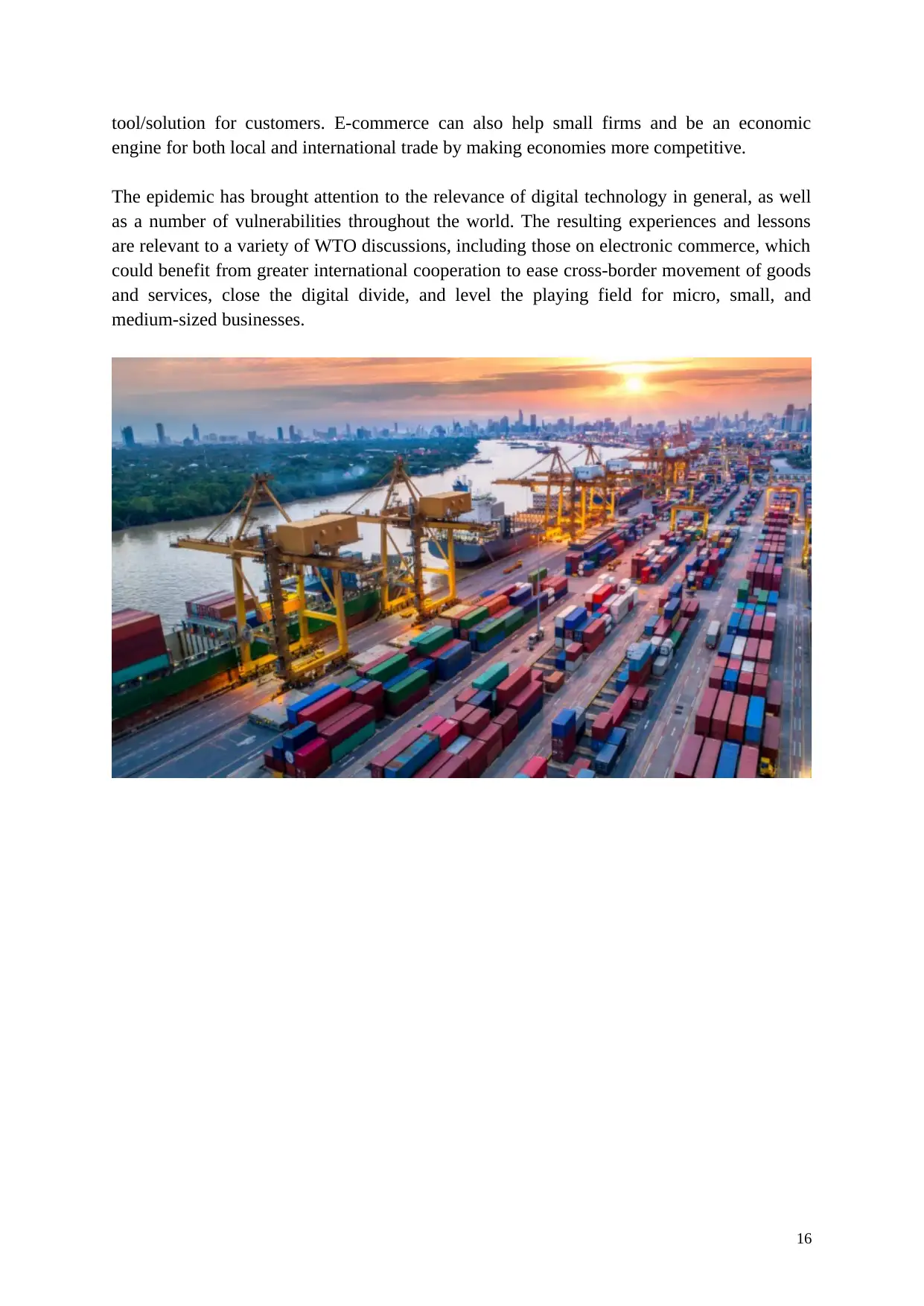
tool/solution for customers. E-commerce can also help small firms and be an economic
engine for both local and international trade by making economies more competitive.
The epidemic has brought attention to the relevance of digital technology in general, as well
as a number of vulnerabilities throughout the world. The resulting experiences and lessons
are relevant to a variety of WTO discussions, including those on electronic commerce, which
could benefit from greater international cooperation to ease cross-border movement of goods
and services, close the digital divide, and level the playing field for micro, small, and
medium-sized businesses.
16
engine for both local and international trade by making economies more competitive.
The epidemic has brought attention to the relevance of digital technology in general, as well
as a number of vulnerabilities throughout the world. The resulting experiences and lessons
are relevant to a variety of WTO discussions, including those on electronic commerce, which
could benefit from greater international cooperation to ease cross-border movement of goods
and services, close the digital divide, and level the playing field for micro, small, and
medium-sized businesses.
16
Secure Best Marks with AI Grader
Need help grading? Try our AI Grader for instant feedback on your assignments.
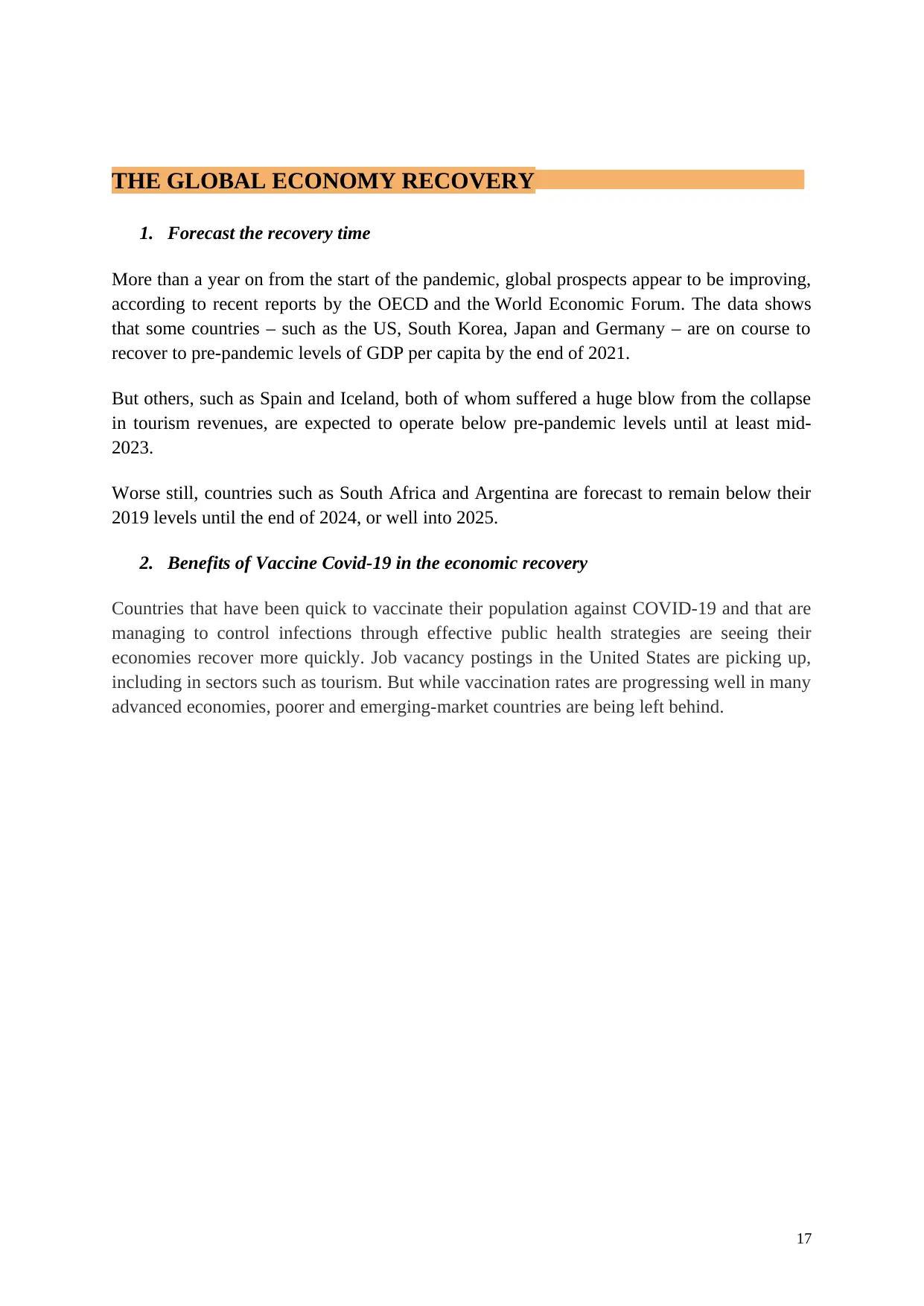
THE GLOBAL ECONOMY RECOVERY
1. Forecast the recovery time
More than a year on from the start of the pandemic, global prospects appear to be improving,
according to recent reports by the OECD and the World Economic Forum. The data shows
that some countries – such as the US, South Korea, Japan and Germany – are on course to
recover to pre-pandemic levels of GDP per capita by the end of 2021.
But others, such as Spain and Iceland, both of whom suffered a huge blow from the collapse
in tourism revenues, are expected to operate below pre-pandemic levels until at least mid-
2023.
Worse still, countries such as South Africa and Argentina are forecast to remain below their
2019 levels until the end of 2024, or well into 2025.
2. Benefits of Vaccine Covid-19 in the economic recovery
Countries that have been quick to vaccinate their population against COVID-19 and that are
managing to control infections through effective public health strategies are seeing their
economies recover more quickly. Job vacancy postings in the United States are picking up,
including in sectors such as tourism. But while vaccination rates are progressing well in many
advanced economies, poorer and emerging-market countries are being left behind.
17
1. Forecast the recovery time
More than a year on from the start of the pandemic, global prospects appear to be improving,
according to recent reports by the OECD and the World Economic Forum. The data shows
that some countries – such as the US, South Korea, Japan and Germany – are on course to
recover to pre-pandemic levels of GDP per capita by the end of 2021.
But others, such as Spain and Iceland, both of whom suffered a huge blow from the collapse
in tourism revenues, are expected to operate below pre-pandemic levels until at least mid-
2023.
Worse still, countries such as South Africa and Argentina are forecast to remain below their
2019 levels until the end of 2024, or well into 2025.
2. Benefits of Vaccine Covid-19 in the economic recovery
Countries that have been quick to vaccinate their population against COVID-19 and that are
managing to control infections through effective public health strategies are seeing their
economies recover more quickly. Job vacancy postings in the United States are picking up,
including in sectors such as tourism. But while vaccination rates are progressing well in many
advanced economies, poorer and emerging-market countries are being left behind.
17
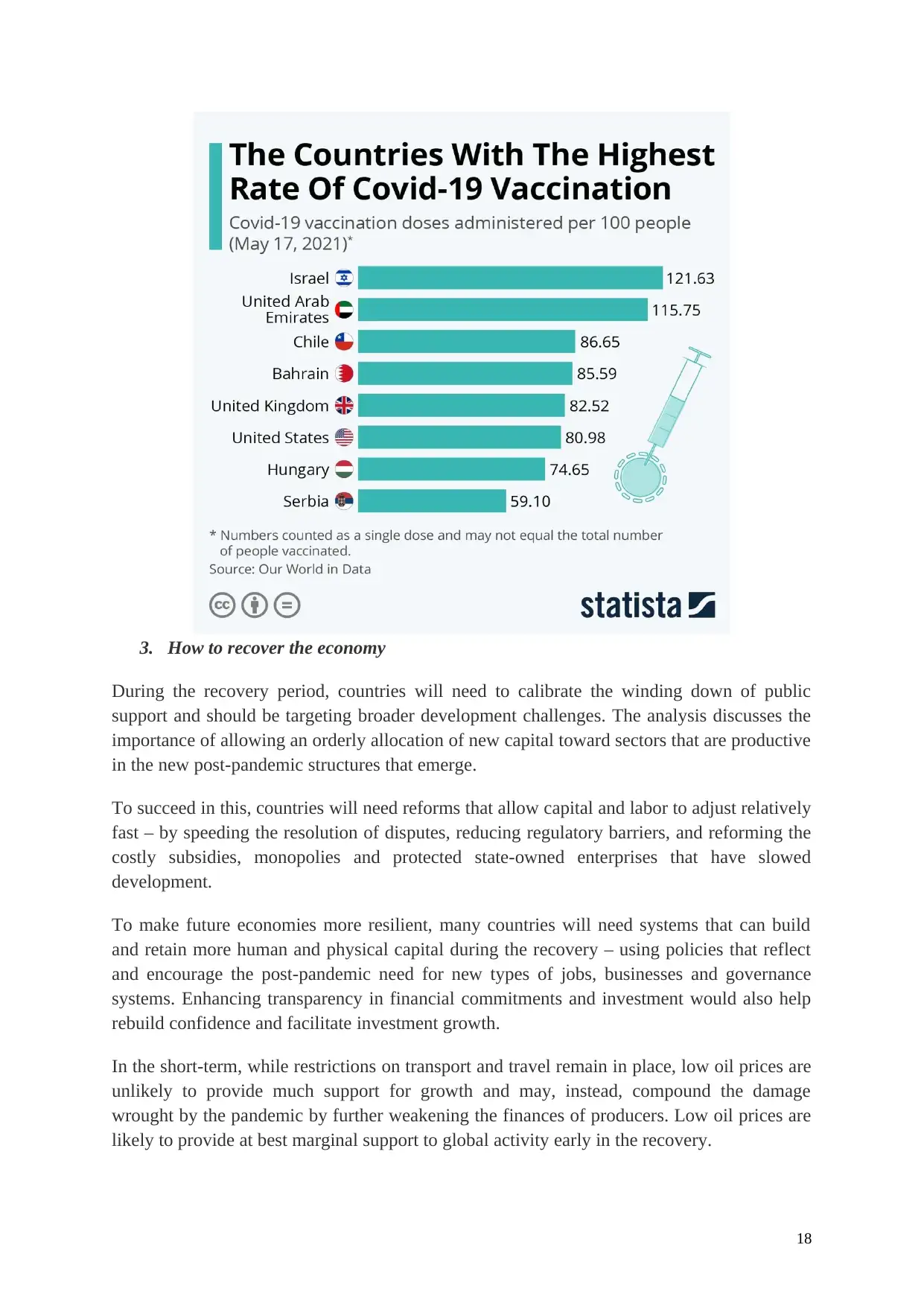
3. How to recover the economy
During the recovery period, countries will need to calibrate the winding down of public
support and should be targeting broader development challenges. The analysis discusses the
importance of allowing an orderly allocation of new capital toward sectors that are productive
in the new post-pandemic structures that emerge.
To succeed in this, countries will need reforms that allow capital and labor to adjust relatively
fast – by speeding the resolution of disputes, reducing regulatory barriers, and reforming the
costly subsidies, monopolies and protected state-owned enterprises that have slowed
development.
To make future economies more resilient, many countries will need systems that can build
and retain more human and physical capital during the recovery – using policies that reflect
and encourage the post-pandemic need for new types of jobs, businesses and governance
systems. Enhancing transparency in financial commitments and investment would also help
rebuild confidence and facilitate investment growth.
In the short-term, while restrictions on transport and travel remain in place, low oil prices are
unlikely to provide much support for growth and may, instead, compound the damage
wrought by the pandemic by further weakening the finances of producers. Low oil prices are
likely to provide at best marginal support to global activity early in the recovery.
18
During the recovery period, countries will need to calibrate the winding down of public
support and should be targeting broader development challenges. The analysis discusses the
importance of allowing an orderly allocation of new capital toward sectors that are productive
in the new post-pandemic structures that emerge.
To succeed in this, countries will need reforms that allow capital and labor to adjust relatively
fast – by speeding the resolution of disputes, reducing regulatory barriers, and reforming the
costly subsidies, monopolies and protected state-owned enterprises that have slowed
development.
To make future economies more resilient, many countries will need systems that can build
and retain more human and physical capital during the recovery – using policies that reflect
and encourage the post-pandemic need for new types of jobs, businesses and governance
systems. Enhancing transparency in financial commitments and investment would also help
rebuild confidence and facilitate investment growth.
In the short-term, while restrictions on transport and travel remain in place, low oil prices are
unlikely to provide much support for growth and may, instead, compound the damage
wrought by the pandemic by further weakening the finances of producers. Low oil prices are
likely to provide at best marginal support to global activity early in the recovery.
18
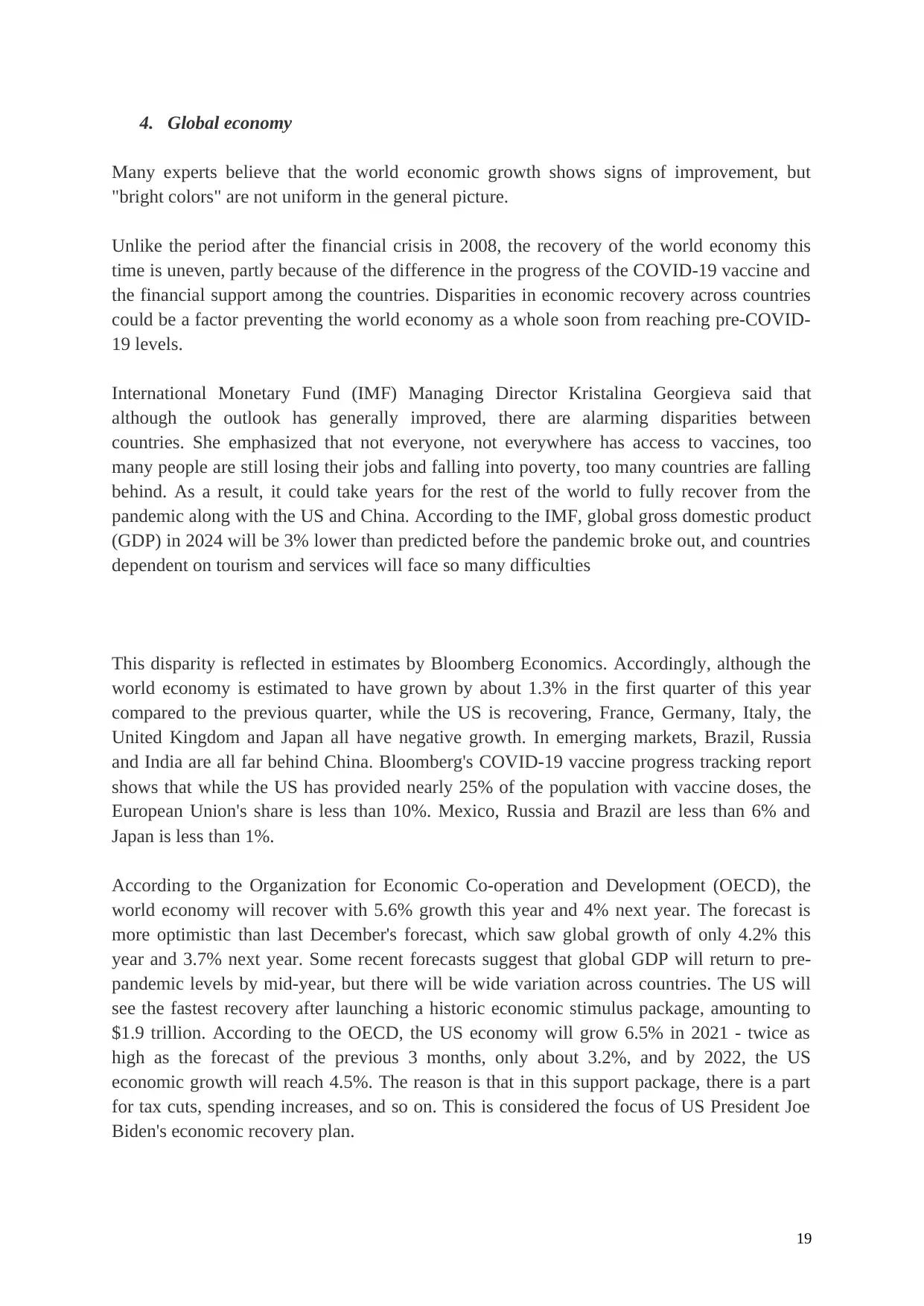
4. Global economy
Many experts believe that the world economic growth shows signs of improvement, but
"bright colors" are not uniform in the general picture.
Unlike the period after the financial crisis in 2008, the recovery of the world economy this
time is uneven, partly because of the difference in the progress of the COVID-19 vaccine and
the financial support among the countries. Disparities in economic recovery across countries
could be a factor preventing the world economy as a whole soon from reaching pre-COVID-
19 levels.
International Monetary Fund (IMF) Managing Director Kristalina Georgieva said that
although the outlook has generally improved, there are alarming disparities between
countries. She emphasized that not everyone, not everywhere has access to vaccines, too
many people are still losing their jobs and falling into poverty, too many countries are falling
behind. As a result, it could take years for the rest of the world to fully recover from the
pandemic along with the US and China. According to the IMF, global gross domestic product
(GDP) in 2024 will be 3% lower than predicted before the pandemic broke out, and countries
dependent on tourism and services will face so many difficulties
This disparity is reflected in estimates by Bloomberg Economics. Accordingly, although the
world economy is estimated to have grown by about 1.3% in the first quarter of this year
compared to the previous quarter, while the US is recovering, France, Germany, Italy, the
United Kingdom and Japan all have negative growth. In emerging markets, Brazil, Russia
and India are all far behind China. Bloomberg's COVID-19 vaccine progress tracking report
shows that while the US has provided nearly 25% of the population with vaccine doses, the
European Union's share is less than 10%. Mexico, Russia and Brazil are less than 6% and
Japan is less than 1%.
According to the Organization for Economic Co-operation and Development (OECD), the
world economy will recover with 5.6% growth this year and 4% next year. The forecast is
more optimistic than last December's forecast, which saw global growth of only 4.2% this
year and 3.7% next year. Some recent forecasts suggest that global GDP will return to pre-
pandemic levels by mid-year, but there will be wide variation across countries. The US will
see the fastest recovery after launching a historic economic stimulus package, amounting to
$1.9 trillion. According to the OECD, the US economy will grow 6.5% in 2021 - twice as
high as the forecast of the previous 3 months, only about 3.2%, and by 2022, the US
economic growth will reach 4.5%. The reason is that in this support package, there is a part
for tax cuts, spending increases, and so on. This is considered the focus of US President Joe
Biden's economic recovery plan.
19
Many experts believe that the world economic growth shows signs of improvement, but
"bright colors" are not uniform in the general picture.
Unlike the period after the financial crisis in 2008, the recovery of the world economy this
time is uneven, partly because of the difference in the progress of the COVID-19 vaccine and
the financial support among the countries. Disparities in economic recovery across countries
could be a factor preventing the world economy as a whole soon from reaching pre-COVID-
19 levels.
International Monetary Fund (IMF) Managing Director Kristalina Georgieva said that
although the outlook has generally improved, there are alarming disparities between
countries. She emphasized that not everyone, not everywhere has access to vaccines, too
many people are still losing their jobs and falling into poverty, too many countries are falling
behind. As a result, it could take years for the rest of the world to fully recover from the
pandemic along with the US and China. According to the IMF, global gross domestic product
(GDP) in 2024 will be 3% lower than predicted before the pandemic broke out, and countries
dependent on tourism and services will face so many difficulties
This disparity is reflected in estimates by Bloomberg Economics. Accordingly, although the
world economy is estimated to have grown by about 1.3% in the first quarter of this year
compared to the previous quarter, while the US is recovering, France, Germany, Italy, the
United Kingdom and Japan all have negative growth. In emerging markets, Brazil, Russia
and India are all far behind China. Bloomberg's COVID-19 vaccine progress tracking report
shows that while the US has provided nearly 25% of the population with vaccine doses, the
European Union's share is less than 10%. Mexico, Russia and Brazil are less than 6% and
Japan is less than 1%.
According to the Organization for Economic Co-operation and Development (OECD), the
world economy will recover with 5.6% growth this year and 4% next year. The forecast is
more optimistic than last December's forecast, which saw global growth of only 4.2% this
year and 3.7% next year. Some recent forecasts suggest that global GDP will return to pre-
pandemic levels by mid-year, but there will be wide variation across countries. The US will
see the fastest recovery after launching a historic economic stimulus package, amounting to
$1.9 trillion. According to the OECD, the US economy will grow 6.5% in 2021 - twice as
high as the forecast of the previous 3 months, only about 3.2%, and by 2022, the US
economic growth will reach 4.5%. The reason is that in this support package, there is a part
for tax cuts, spending increases, and so on. This is considered the focus of US President Joe
Biden's economic recovery plan.
19
Paraphrase This Document
Need a fresh take? Get an instant paraphrase of this document with our AI Paraphraser
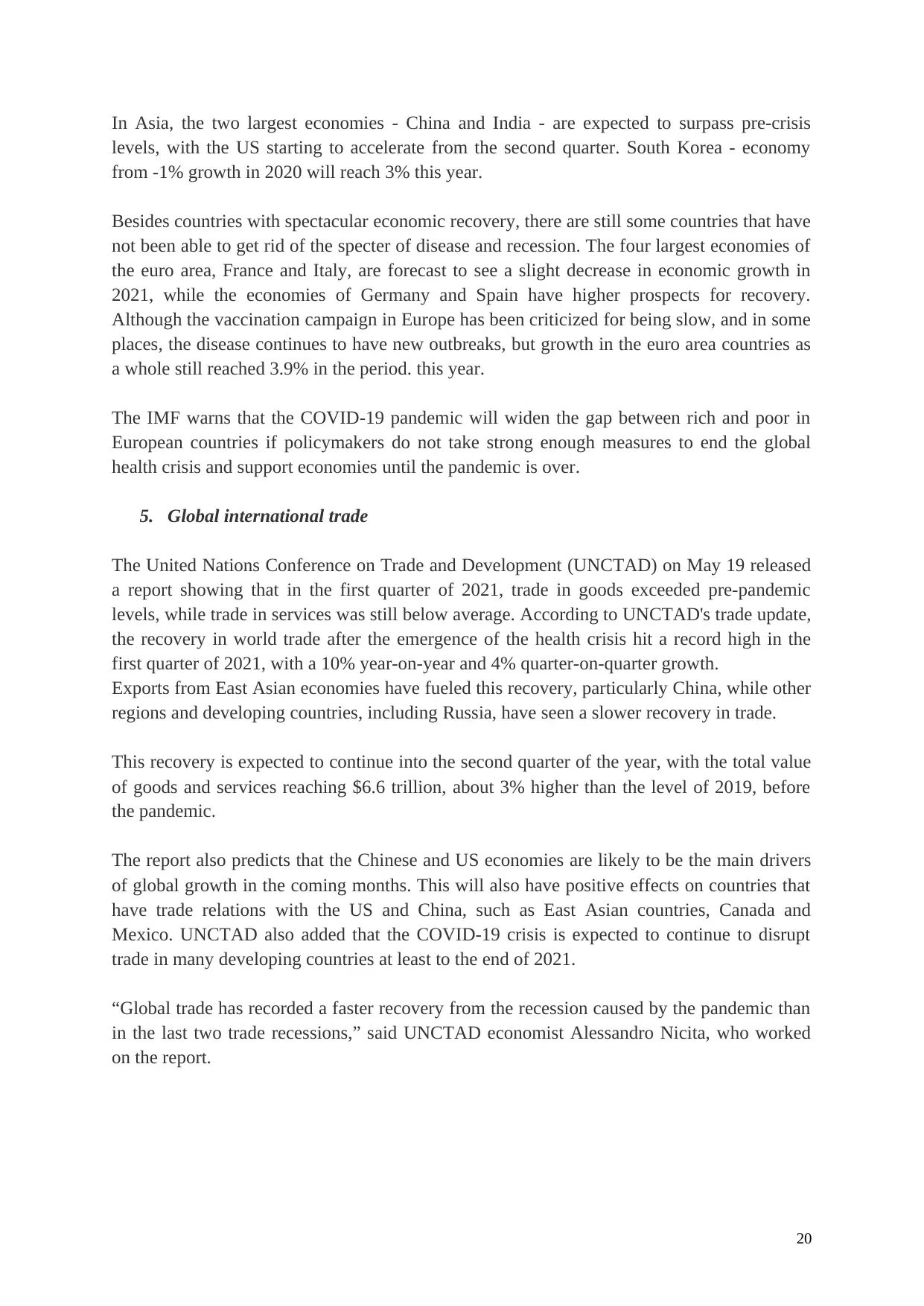
In Asia, the two largest economies - China and India - are expected to surpass pre-crisis
levels, with the US starting to accelerate from the second quarter. South Korea - economy
from -1% growth in 2020 will reach 3% this year.
Besides countries with spectacular economic recovery, there are still some countries that have
not been able to get rid of the specter of disease and recession. The four largest economies of
the euro area, France and Italy, are forecast to see a slight decrease in economic growth in
2021, while the economies of Germany and Spain have higher prospects for recovery.
Although the vaccination campaign in Europe has been criticized for being slow, and in some
places, the disease continues to have new outbreaks, but growth in the euro area countries as
a whole still reached 3.9% in the period. this year.
The IMF warns that the COVID-19 pandemic will widen the gap between rich and poor in
European countries if policymakers do not take strong enough measures to end the global
health crisis and support economies until the pandemic is over.
5. Global international trade
The United Nations Conference on Trade and Development (UNCTAD) on May 19 released
a report showing that in the first quarter of 2021, trade in goods exceeded pre-pandemic
levels, while trade in services was still below average. According to UNCTAD's trade update,
the recovery in world trade after the emergence of the health crisis hit a record high in the
first quarter of 2021, with a 10% year-on-year and 4% quarter-on-quarter growth.
Exports from East Asian economies have fueled this recovery, particularly China, while other
regions and developing countries, including Russia, have seen a slower recovery in trade.
This recovery is expected to continue into the second quarter of the year, with the total value
of goods and services reaching $6.6 trillion, about 3% higher than the level of 2019, before
the pandemic.
The report also predicts that the Chinese and US economies are likely to be the main drivers
of global growth in the coming months. This will also have positive effects on countries that
have trade relations with the US and China, such as East Asian countries, Canada and
Mexico. UNCTAD also added that the COVID-19 crisis is expected to continue to disrupt
trade in many developing countries at least to the end of 2021.
“Global trade has recorded a faster recovery from the recession caused by the pandemic than
in the last two trade recessions,” said UNCTAD economist Alessandro Nicita, who worked
on the report.
20
levels, with the US starting to accelerate from the second quarter. South Korea - economy
from -1% growth in 2020 will reach 3% this year.
Besides countries with spectacular economic recovery, there are still some countries that have
not been able to get rid of the specter of disease and recession. The four largest economies of
the euro area, France and Italy, are forecast to see a slight decrease in economic growth in
2021, while the economies of Germany and Spain have higher prospects for recovery.
Although the vaccination campaign in Europe has been criticized for being slow, and in some
places, the disease continues to have new outbreaks, but growth in the euro area countries as
a whole still reached 3.9% in the period. this year.
The IMF warns that the COVID-19 pandemic will widen the gap between rich and poor in
European countries if policymakers do not take strong enough measures to end the global
health crisis and support economies until the pandemic is over.
5. Global international trade
The United Nations Conference on Trade and Development (UNCTAD) on May 19 released
a report showing that in the first quarter of 2021, trade in goods exceeded pre-pandemic
levels, while trade in services was still below average. According to UNCTAD's trade update,
the recovery in world trade after the emergence of the health crisis hit a record high in the
first quarter of 2021, with a 10% year-on-year and 4% quarter-on-quarter growth.
Exports from East Asian economies have fueled this recovery, particularly China, while other
regions and developing countries, including Russia, have seen a slower recovery in trade.
This recovery is expected to continue into the second quarter of the year, with the total value
of goods and services reaching $6.6 trillion, about 3% higher than the level of 2019, before
the pandemic.
The report also predicts that the Chinese and US economies are likely to be the main drivers
of global growth in the coming months. This will also have positive effects on countries that
have trade relations with the US and China, such as East Asian countries, Canada and
Mexico. UNCTAD also added that the COVID-19 crisis is expected to continue to disrupt
trade in many developing countries at least to the end of 2021.
“Global trade has recorded a faster recovery from the recession caused by the pandemic than
in the last two trade recessions,” said UNCTAD economist Alessandro Nicita, who worked
on the report.
20

UNCTAD economist Alessandro Nicita
In his opinion, it will take four quarters after the start of the recession due to the pandemic for
world trade to return to pre-recession levels. It took 13 quarters for world trade to recover
from the 2015 recession, due to structural changes in East Asian economies and falling
commodity prices, and 9 quarters to recover from the 2009 recession caused by the financial
crisis. caused by the global financial crisis.
INDIVIDUAL LESSON LEARNT
NGUYỄN VŨ NGỌC THUỶ - BABAWE18668
This International Economics course provided me with an analysis of the economic
relationships between countries, covering both trade and monetary issues, the balance of
payments accounts, open economy income identities, the liquidity trap, and the effect of
currency valuations. The most interesting thing was that I had a chance to explore reality
topics such as why countries trade with each other, the effect of international trade and how
governments have to carefully consider their trade policies and the macroeconomic landscape
to ensure local social and economic goals are met. In general, I was given a comprehensive
understanding of the current policy environment and its impact on international trade
relations.
More specifically, after COVID-19, I realized the importance of trade activities between
countries. The pandemic made countries close their borders, made import and export more
difficult and led to the collapse of many businesses. The economic shock caused by the
21
In his opinion, it will take four quarters after the start of the recession due to the pandemic for
world trade to return to pre-recession levels. It took 13 quarters for world trade to recover
from the 2015 recession, due to structural changes in East Asian economies and falling
commodity prices, and 9 quarters to recover from the 2009 recession caused by the financial
crisis. caused by the global financial crisis.
INDIVIDUAL LESSON LEARNT
NGUYỄN VŨ NGỌC THUỶ - BABAWE18668
This International Economics course provided me with an analysis of the economic
relationships between countries, covering both trade and monetary issues, the balance of
payments accounts, open economy income identities, the liquidity trap, and the effect of
currency valuations. The most interesting thing was that I had a chance to explore reality
topics such as why countries trade with each other, the effect of international trade and how
governments have to carefully consider their trade policies and the macroeconomic landscape
to ensure local social and economic goals are met. In general, I was given a comprehensive
understanding of the current policy environment and its impact on international trade
relations.
More specifically, after COVID-19, I realized the importance of trade activities between
countries. The pandemic made countries close their borders, made import and export more
difficult and led to the collapse of many businesses. The economic shock caused by the
21
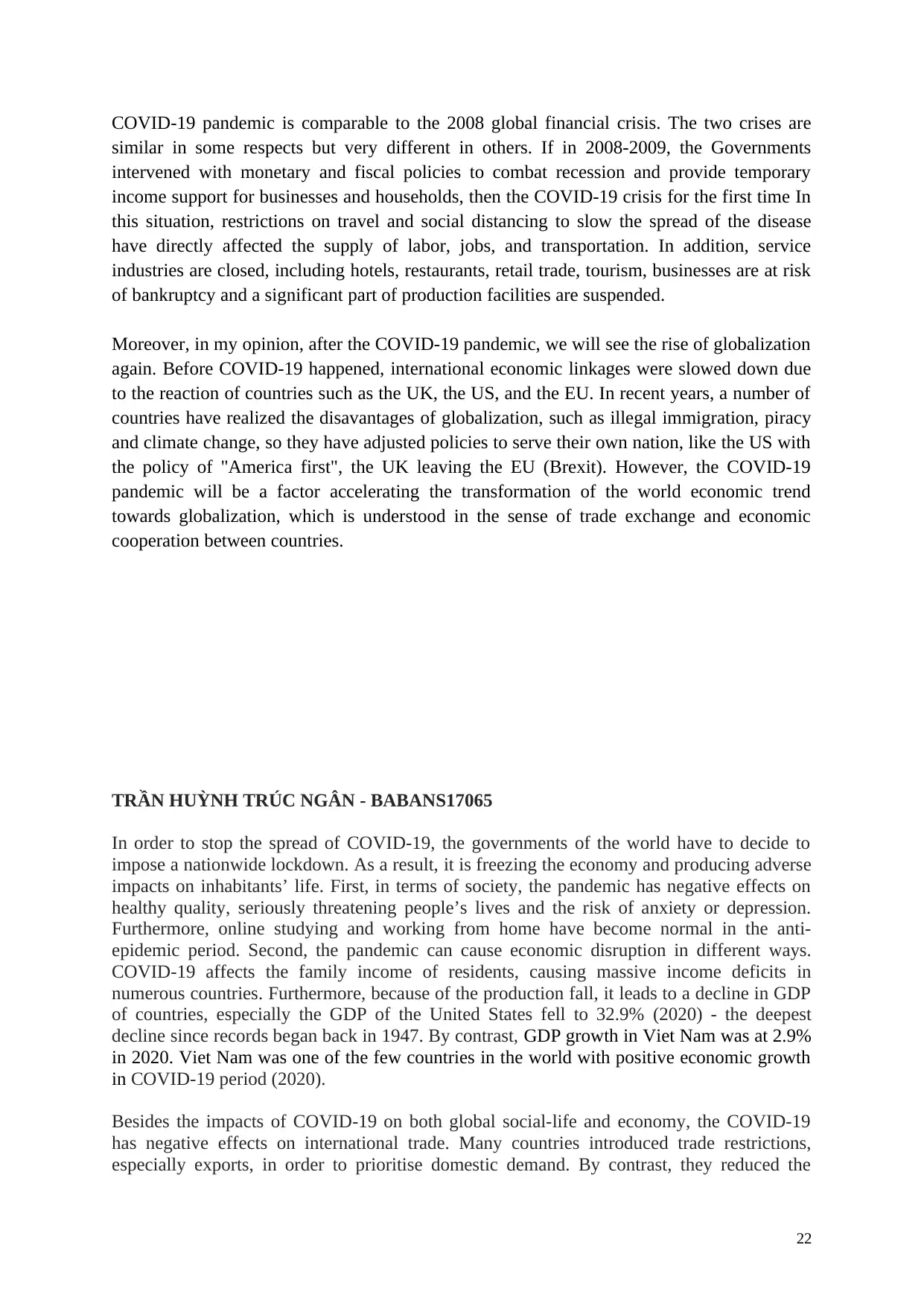
COVID-19 pandemic is comparable to the 2008 global financial crisis. The two crises are
similar in some respects but very different in others. If in 2008-2009, the Governments
intervened with monetary and fiscal policies to combat recession and provide temporary
income support for businesses and households, then the COVID-19 crisis for the first time In
this situation, restrictions on travel and social distancing to slow the spread of the disease
have directly affected the supply of labor, jobs, and transportation. In addition, service
industries are closed, including hotels, restaurants, retail trade, tourism, businesses are at risk
of bankruptcy and a significant part of production facilities are suspended.
Moreover, in my opinion, after the COVID-19 pandemic, we will see the rise of globalization
again. Before COVID-19 happened, international economic linkages were slowed down due
to the reaction of countries such as the UK, the US, and the EU. In recent years, a number of
countries have realized the disavantages of globalization, such as illegal immigration, piracy
and climate change, so they have adjusted policies to serve their own nation, like the US with
the policy of "America first", the UK leaving the EU (Brexit). However, the COVID-19
pandemic will be a factor accelerating the transformation of the world economic trend
towards globalization, which is understood in the sense of trade exchange and economic
cooperation between countries.
TRẦN HUỲNH TRÚC NGÂN - BABANS17065
In order to stop the spread of COVID-19, the governments of the world have to decide to
impose a nationwide lockdown. As a result, it is freezing the economy and producing adverse
impacts on inhabitants’ life. First, in terms of society, the pandemic has negative effects on
healthy quality, seriously threatening people’s lives and the risk of anxiety or depression.
Furthermore, online studying and working from home have become normal in the anti-
epidemic period. Second, the pandemic can cause economic disruption in different ways.
COVID-19 affects the family income of residents, causing massive income deficits in
numerous countries. Furthermore, because of the production fall, it leads to a decline in GDP
of countries, especially the GDP of the United States fell to 32.9% (2020) - the deepest
decline since records began back in 1947. By contrast, GDP growth in Viet Nam was at 2.9%
in 2020. Viet Nam was one of the few countries in the world with positive economic growth
in COVID-19 period (2020).
Besides the impacts of COVID-19 on both global social-life and economy, the COVID-19
has negative effects on international trade. Many countries introduced trade restrictions,
especially exports, in order to prioritise domestic demand. By contrast, they reduced the
22
similar in some respects but very different in others. If in 2008-2009, the Governments
intervened with monetary and fiscal policies to combat recession and provide temporary
income support for businesses and households, then the COVID-19 crisis for the first time In
this situation, restrictions on travel and social distancing to slow the spread of the disease
have directly affected the supply of labor, jobs, and transportation. In addition, service
industries are closed, including hotels, restaurants, retail trade, tourism, businesses are at risk
of bankruptcy and a significant part of production facilities are suspended.
Moreover, in my opinion, after the COVID-19 pandemic, we will see the rise of globalization
again. Before COVID-19 happened, international economic linkages were slowed down due
to the reaction of countries such as the UK, the US, and the EU. In recent years, a number of
countries have realized the disavantages of globalization, such as illegal immigration, piracy
and climate change, so they have adjusted policies to serve their own nation, like the US with
the policy of "America first", the UK leaving the EU (Brexit). However, the COVID-19
pandemic will be a factor accelerating the transformation of the world economic trend
towards globalization, which is understood in the sense of trade exchange and economic
cooperation between countries.
TRẦN HUỲNH TRÚC NGÂN - BABANS17065
In order to stop the spread of COVID-19, the governments of the world have to decide to
impose a nationwide lockdown. As a result, it is freezing the economy and producing adverse
impacts on inhabitants’ life. First, in terms of society, the pandemic has negative effects on
healthy quality, seriously threatening people’s lives and the risk of anxiety or depression.
Furthermore, online studying and working from home have become normal in the anti-
epidemic period. Second, the pandemic can cause economic disruption in different ways.
COVID-19 affects the family income of residents, causing massive income deficits in
numerous countries. Furthermore, because of the production fall, it leads to a decline in GDP
of countries, especially the GDP of the United States fell to 32.9% (2020) - the deepest
decline since records began back in 1947. By contrast, GDP growth in Viet Nam was at 2.9%
in 2020. Viet Nam was one of the few countries in the world with positive economic growth
in COVID-19 period (2020).
Besides the impacts of COVID-19 on both global social-life and economy, the COVID-19
has negative effects on international trade. Many countries introduced trade restrictions,
especially exports, in order to prioritise domestic demand. By contrast, they reduced the
22
Secure Best Marks with AI Grader
Need help grading? Try our AI Grader for instant feedback on your assignments.
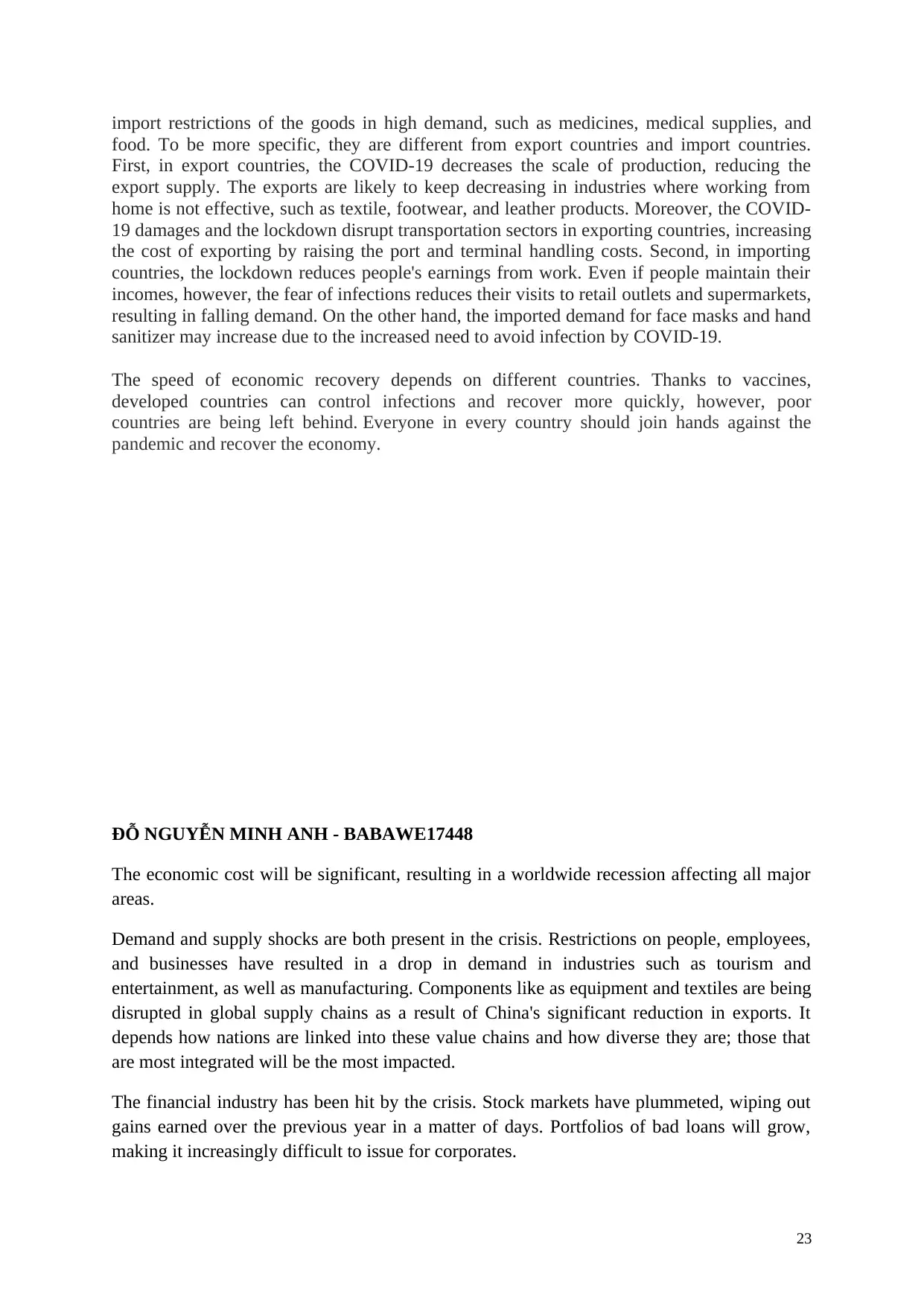
import restrictions of the goods in high demand, such as medicines, medical supplies, and
food. To be more specific, they are different from export countries and import countries.
First, in export countries, the COVID-19 decreases the scale of production, reducing the
export supply. The exports are likely to keep decreasing in industries where working from
home is not effective, such as textile, footwear, and leather products. Moreover, the COVID-
19 damages and the lockdown disrupt transportation sectors in exporting countries, increasing
the cost of exporting by raising the port and terminal handling costs. Second, in importing
countries, the lockdown reduces people's earnings from work. Even if people maintain their
incomes, however, the fear of infections reduces their visits to retail outlets and supermarkets,
resulting in falling demand. On the other hand, the imported demand for face masks and hand
sanitizer may increase due to the increased need to avoid infection by COVID-19.
The speed of economic recovery depends on different countries. Thanks to vaccines,
developed countries can control infections and recover more quickly, however, poor
countries are being left behind. Everyone in every country should join hands against the
pandemic and recover the economy.
ĐỖ NGUYỄN MINH ANH - BABAWE17448
The economic cost will be significant, resulting in a worldwide recession affecting all major
areas.
Demand and supply shocks are both present in the crisis. Restrictions on people, employees,
and businesses have resulted in a drop in demand in industries such as tourism and
entertainment, as well as manufacturing. Components like as equipment and textiles are being
disrupted in global supply chains as a result of China's significant reduction in exports. It
depends how nations are linked into these value chains and how diverse they are; those that
are most integrated will be the most impacted.
The financial industry has been hit by the crisis. Stock markets have plummeted, wiping out
gains earned over the previous year in a matter of days. Portfolios of bad loans will grow,
making it increasingly difficult to issue for corporates.
23
food. To be more specific, they are different from export countries and import countries.
First, in export countries, the COVID-19 decreases the scale of production, reducing the
export supply. The exports are likely to keep decreasing in industries where working from
home is not effective, such as textile, footwear, and leather products. Moreover, the COVID-
19 damages and the lockdown disrupt transportation sectors in exporting countries, increasing
the cost of exporting by raising the port and terminal handling costs. Second, in importing
countries, the lockdown reduces people's earnings from work. Even if people maintain their
incomes, however, the fear of infections reduces their visits to retail outlets and supermarkets,
resulting in falling demand. On the other hand, the imported demand for face masks and hand
sanitizer may increase due to the increased need to avoid infection by COVID-19.
The speed of economic recovery depends on different countries. Thanks to vaccines,
developed countries can control infections and recover more quickly, however, poor
countries are being left behind. Everyone in every country should join hands against the
pandemic and recover the economy.
ĐỖ NGUYỄN MINH ANH - BABAWE17448
The economic cost will be significant, resulting in a worldwide recession affecting all major
areas.
Demand and supply shocks are both present in the crisis. Restrictions on people, employees,
and businesses have resulted in a drop in demand in industries such as tourism and
entertainment, as well as manufacturing. Components like as equipment and textiles are being
disrupted in global supply chains as a result of China's significant reduction in exports. It
depends how nations are linked into these value chains and how diverse they are; those that
are most integrated will be the most impacted.
The financial industry has been hit by the crisis. Stock markets have plummeted, wiping out
gains earned over the previous year in a matter of days. Portfolios of bad loans will grow,
making it increasingly difficult to issue for corporates.
23
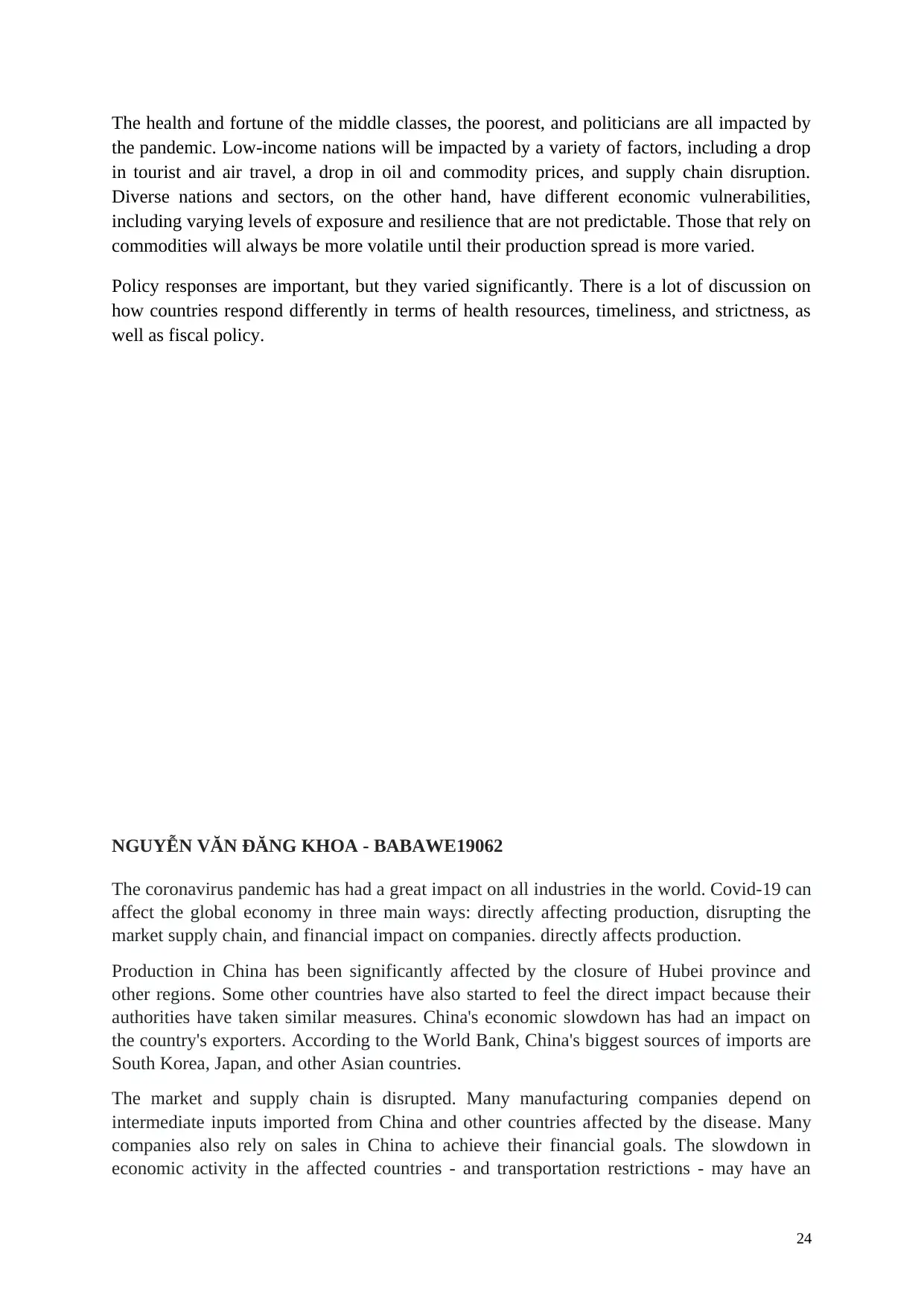
The health and fortune of the middle classes, the poorest, and politicians are all impacted by
the pandemic. Low-income nations will be impacted by a variety of factors, including a drop
in tourist and air travel, a drop in oil and commodity prices, and supply chain disruption.
Diverse nations and sectors, on the other hand, have different economic vulnerabilities,
including varying levels of exposure and resilience that are not predictable. Those that rely on
commodities will always be more volatile until their production spread is more varied.
Policy responses are important, but they varied significantly. There is a lot of discussion on
how countries respond differently in terms of health resources, timeliness, and strictness, as
well as fiscal policy.
NGUYỄN VĂN ĐĂNG KHOA - BABAWE19062
The coronavirus pandemic has had a great impact on all industries in the world. Covid-19 can
affect the global economy in three main ways: directly affecting production, disrupting the
market supply chain, and financial impact on companies. directly affects production.
Production in China has been significantly affected by the closure of Hubei province and
other regions. Some other countries have also started to feel the direct impact because their
authorities have taken similar measures. China's economic slowdown has had an impact on
the country's exporters. According to the World Bank, China's biggest sources of imports are
South Korea, Japan, and other Asian countries.
The market and supply chain is disrupted. Many manufacturing companies depend on
intermediate inputs imported from China and other countries affected by the disease. Many
companies also rely on sales in China to achieve their financial goals. The slowdown in
economic activity in the affected countries - and transportation restrictions - may have an
24
the pandemic. Low-income nations will be impacted by a variety of factors, including a drop
in tourist and air travel, a drop in oil and commodity prices, and supply chain disruption.
Diverse nations and sectors, on the other hand, have different economic vulnerabilities,
including varying levels of exposure and resilience that are not predictable. Those that rely on
commodities will always be more volatile until their production spread is more varied.
Policy responses are important, but they varied significantly. There is a lot of discussion on
how countries respond differently in terms of health resources, timeliness, and strictness, as
well as fiscal policy.
NGUYỄN VĂN ĐĂNG KHOA - BABAWE19062
The coronavirus pandemic has had a great impact on all industries in the world. Covid-19 can
affect the global economy in three main ways: directly affecting production, disrupting the
market supply chain, and financial impact on companies. directly affects production.
Production in China has been significantly affected by the closure of Hubei province and
other regions. Some other countries have also started to feel the direct impact because their
authorities have taken similar measures. China's economic slowdown has had an impact on
the country's exporters. According to the World Bank, China's biggest sources of imports are
South Korea, Japan, and other Asian countries.
The market and supply chain is disrupted. Many manufacturing companies depend on
intermediate inputs imported from China and other countries affected by the disease. Many
companies also rely on sales in China to achieve their financial goals. The slowdown in
economic activity in the affected countries - and transportation restrictions - may have an
24
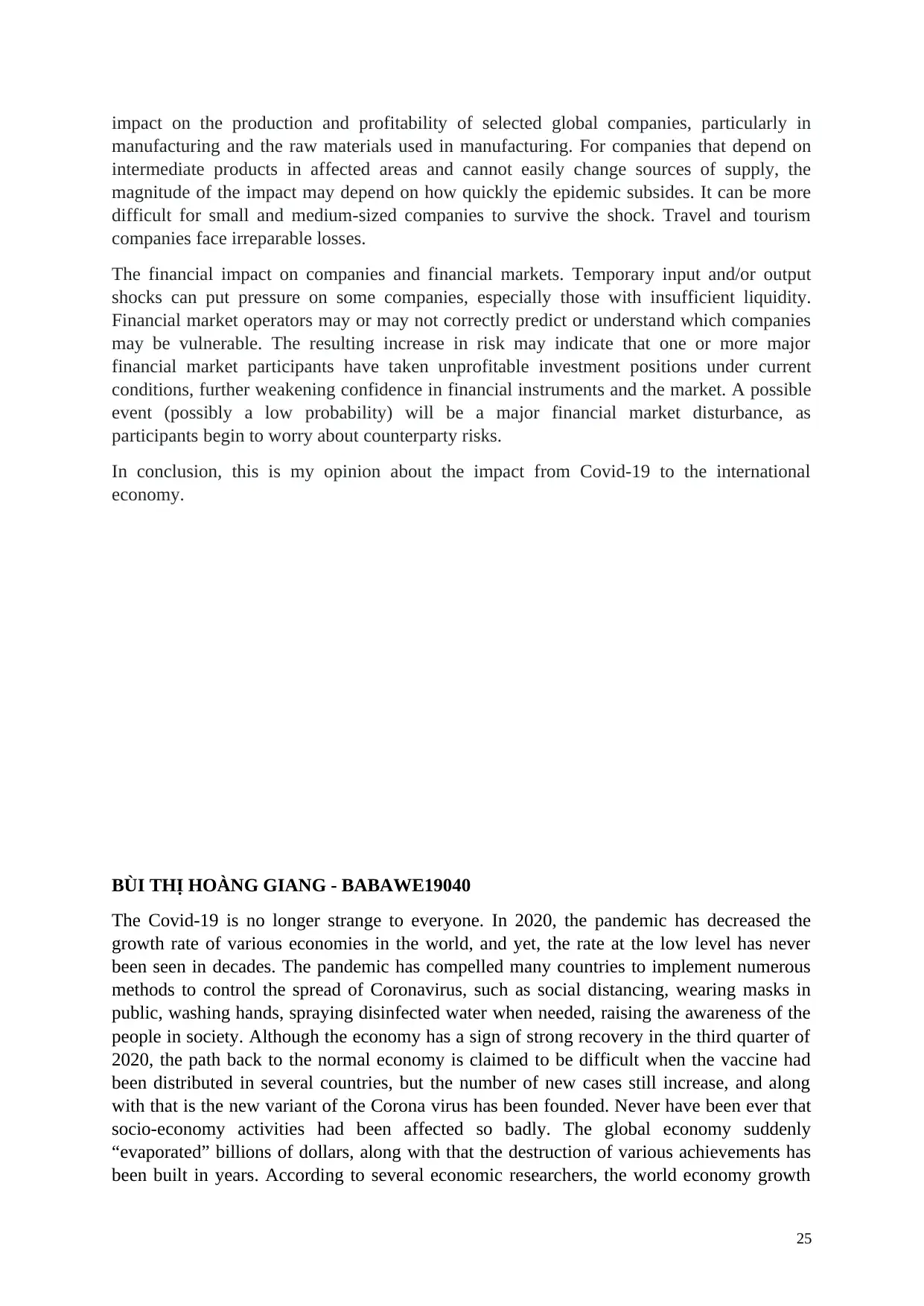
impact on the production and profitability of selected global companies, particularly in
manufacturing and the raw materials used in manufacturing. For companies that depend on
intermediate products in affected areas and cannot easily change sources of supply, the
magnitude of the impact may depend on how quickly the epidemic subsides. It can be more
difficult for small and medium-sized companies to survive the shock. Travel and tourism
companies face irreparable losses.
The financial impact on companies and financial markets. Temporary input and/or output
shocks can put pressure on some companies, especially those with insufficient liquidity.
Financial market operators may or may not correctly predict or understand which companies
may be vulnerable. The resulting increase in risk may indicate that one or more major
financial market participants have taken unprofitable investment positions under current
conditions, further weakening confidence in financial instruments and the market. A possible
event (possibly a low probability) will be a major financial market disturbance, as
participants begin to worry about counterparty risks.
In conclusion, this is my opinion about the impact from Covid-19 to the international
economy.
BÙI THỊ HOÀNG GIANG - BABAWE19040
The Covid-19 is no longer strange to everyone. In 2020, the pandemic has decreased the
growth rate of various economies in the world, and yet, the rate at the low level has never
been seen in decades. The pandemic has compelled many countries to implement numerous
methods to control the spread of Coronavirus, such as social distancing, wearing masks in
public, washing hands, spraying disinfected water when needed, raising the awareness of the
people in society. Although the economy has a sign of strong recovery in the third quarter of
2020, the path back to the normal economy is claimed to be difficult when the vaccine had
been distributed in several countries, but the number of new cases still increase, and along
with that is the new variant of the Corona virus has been founded. Never have been ever that
socio-economy activities had been affected so badly. The global economy suddenly
“evaporated” billions of dollars, along with that the destruction of various achievements has
been built in years. According to several economic researchers, the world economy growth
25
manufacturing and the raw materials used in manufacturing. For companies that depend on
intermediate products in affected areas and cannot easily change sources of supply, the
magnitude of the impact may depend on how quickly the epidemic subsides. It can be more
difficult for small and medium-sized companies to survive the shock. Travel and tourism
companies face irreparable losses.
The financial impact on companies and financial markets. Temporary input and/or output
shocks can put pressure on some companies, especially those with insufficient liquidity.
Financial market operators may or may not correctly predict or understand which companies
may be vulnerable. The resulting increase in risk may indicate that one or more major
financial market participants have taken unprofitable investment positions under current
conditions, further weakening confidence in financial instruments and the market. A possible
event (possibly a low probability) will be a major financial market disturbance, as
participants begin to worry about counterparty risks.
In conclusion, this is my opinion about the impact from Covid-19 to the international
economy.
BÙI THỊ HOÀNG GIANG - BABAWE19040
The Covid-19 is no longer strange to everyone. In 2020, the pandemic has decreased the
growth rate of various economies in the world, and yet, the rate at the low level has never
been seen in decades. The pandemic has compelled many countries to implement numerous
methods to control the spread of Coronavirus, such as social distancing, wearing masks in
public, washing hands, spraying disinfected water when needed, raising the awareness of the
people in society. Although the economy has a sign of strong recovery in the third quarter of
2020, the path back to the normal economy is claimed to be difficult when the vaccine had
been distributed in several countries, but the number of new cases still increase, and along
with that is the new variant of the Corona virus has been founded. Never have been ever that
socio-economy activities had been affected so badly. The global economy suddenly
“evaporated” billions of dollars, along with that the destruction of various achievements has
been built in years. According to several economic researchers, the world economy growth
25
Paraphrase This Document
Need a fresh take? Get an instant paraphrase of this document with our AI Paraphraser
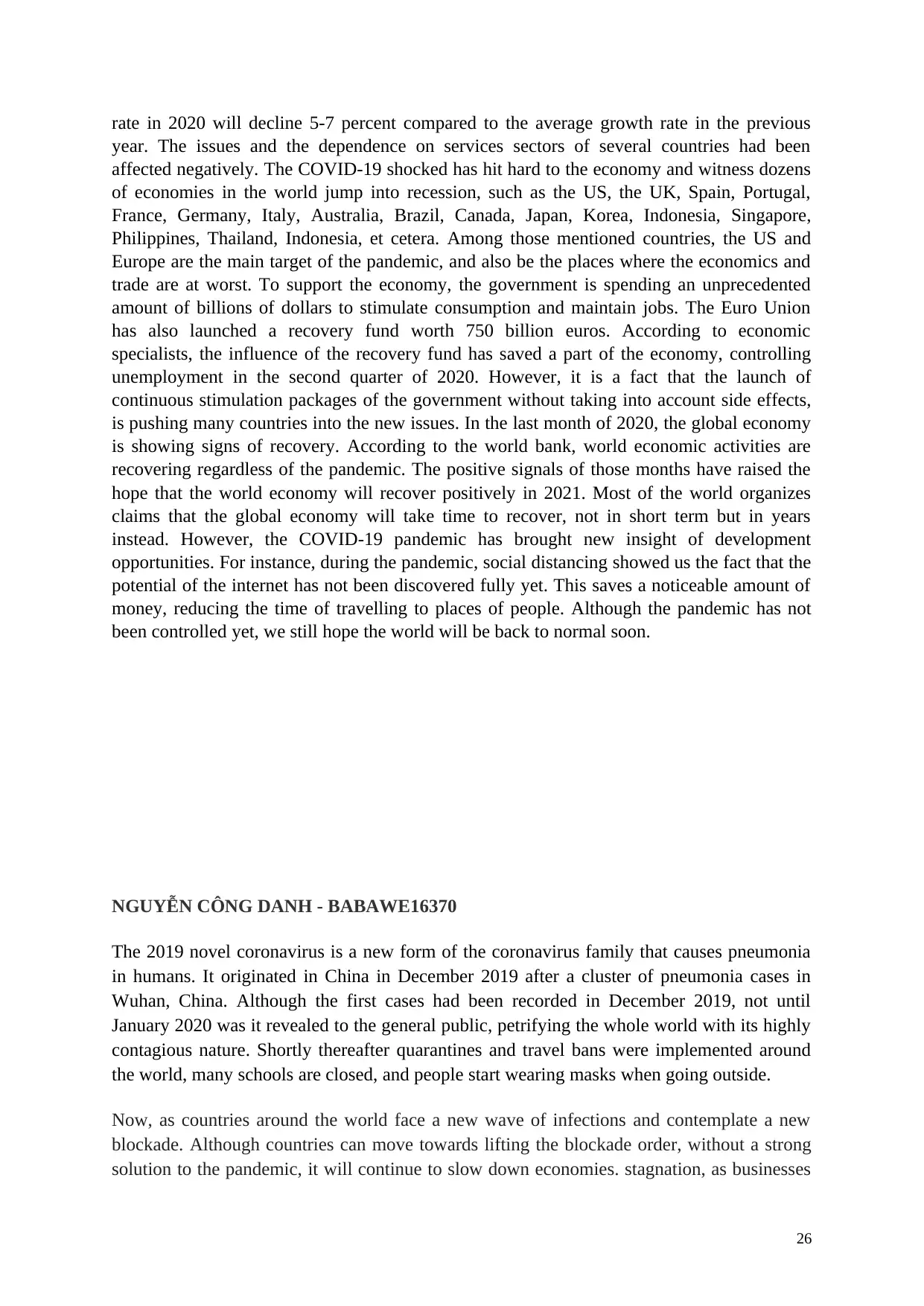
rate in 2020 will decline 5-7 percent compared to the average growth rate in the previous
year. The issues and the dependence on services sectors of several countries had been
affected negatively. The COVID-19 shocked has hit hard to the economy and witness dozens
of economies in the world jump into recession, such as the US, the UK, Spain, Portugal,
France, Germany, Italy, Australia, Brazil, Canada, Japan, Korea, Indonesia, Singapore,
Philippines, Thailand, Indonesia, et cetera. Among those mentioned countries, the US and
Europe are the main target of the pandemic, and also be the places where the economics and
trade are at worst. To support the economy, the government is spending an unprecedented
amount of billions of dollars to stimulate consumption and maintain jobs. The Euro Union
has also launched a recovery fund worth 750 billion euros. According to economic
specialists, the influence of the recovery fund has saved a part of the economy, controlling
unemployment in the second quarter of 2020. However, it is a fact that the launch of
continuous stimulation packages of the government without taking into account side effects,
is pushing many countries into the new issues. In the last month of 2020, the global economy
is showing signs of recovery. According to the world bank, world economic activities are
recovering regardless of the pandemic. The positive signals of those months have raised the
hope that the world economy will recover positively in 2021. Most of the world organizes
claims that the global economy will take time to recover, not in short term but in years
instead. However, the COVID-19 pandemic has brought new insight of development
opportunities. For instance, during the pandemic, social distancing showed us the fact that the
potential of the internet has not been discovered fully yet. This saves a noticeable amount of
money, reducing the time of travelling to places of people. Although the pandemic has not
been controlled yet, we still hope the world will be back to normal soon.
NGUYỄN CÔNG DANH - BABAWE16370
The 2019 novel coronavirus is a new form of the coronavirus family that causes pneumonia
in humans. It originated in China in December 2019 after a cluster of pneumonia cases in
Wuhan, China. Although the first cases had been recorded in December 2019, not until
January 2020 was it revealed to the general public, petrifying the whole world with its highly
contagious nature. Shortly thereafter quarantines and travel bans were implemented around
the world, many schools are closed, and people start wearing masks when going outside.
Now, as countries around the world face a new wave of infections and contemplate a new
blockade. Although countries can move towards lifting the blockade order, without a strong
solution to the pandemic, it will continue to slow down economies. stagnation, as businesses
26
year. The issues and the dependence on services sectors of several countries had been
affected negatively. The COVID-19 shocked has hit hard to the economy and witness dozens
of economies in the world jump into recession, such as the US, the UK, Spain, Portugal,
France, Germany, Italy, Australia, Brazil, Canada, Japan, Korea, Indonesia, Singapore,
Philippines, Thailand, Indonesia, et cetera. Among those mentioned countries, the US and
Europe are the main target of the pandemic, and also be the places where the economics and
trade are at worst. To support the economy, the government is spending an unprecedented
amount of billions of dollars to stimulate consumption and maintain jobs. The Euro Union
has also launched a recovery fund worth 750 billion euros. According to economic
specialists, the influence of the recovery fund has saved a part of the economy, controlling
unemployment in the second quarter of 2020. However, it is a fact that the launch of
continuous stimulation packages of the government without taking into account side effects,
is pushing many countries into the new issues. In the last month of 2020, the global economy
is showing signs of recovery. According to the world bank, world economic activities are
recovering regardless of the pandemic. The positive signals of those months have raised the
hope that the world economy will recover positively in 2021. Most of the world organizes
claims that the global economy will take time to recover, not in short term but in years
instead. However, the COVID-19 pandemic has brought new insight of development
opportunities. For instance, during the pandemic, social distancing showed us the fact that the
potential of the internet has not been discovered fully yet. This saves a noticeable amount of
money, reducing the time of travelling to places of people. Although the pandemic has not
been controlled yet, we still hope the world will be back to normal soon.
NGUYỄN CÔNG DANH - BABAWE16370
The 2019 novel coronavirus is a new form of the coronavirus family that causes pneumonia
in humans. It originated in China in December 2019 after a cluster of pneumonia cases in
Wuhan, China. Although the first cases had been recorded in December 2019, not until
January 2020 was it revealed to the general public, petrifying the whole world with its highly
contagious nature. Shortly thereafter quarantines and travel bans were implemented around
the world, many schools are closed, and people start wearing masks when going outside.
Now, as countries around the world face a new wave of infections and contemplate a new
blockade. Although countries can move towards lifting the blockade order, without a strong
solution to the pandemic, it will continue to slow down economies. stagnation, as businesses
26
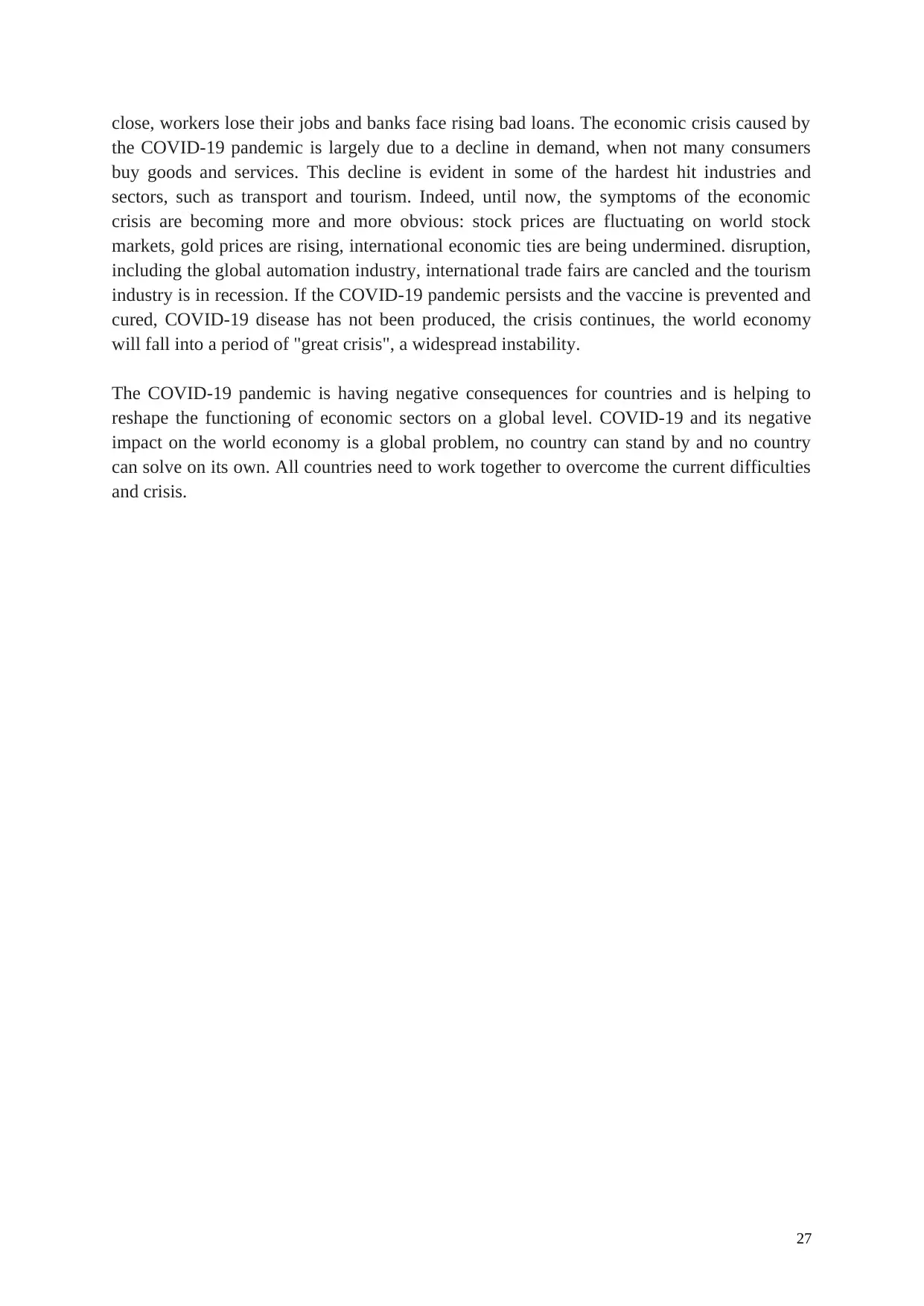
close, workers lose their jobs and banks face rising bad loans. The economic crisis caused by
the COVID-19 pandemic is largely due to a decline in demand, when not many consumers
buy goods and services. This decline is evident in some of the hardest hit industries and
sectors, such as transport and tourism. Indeed, until now, the symptoms of the economic
crisis are becoming more and more obvious: stock prices are fluctuating on world stock
markets, gold prices are rising, international economic ties are being undermined. disruption,
including the global automation industry, international trade fairs are cancled and the tourism
industry is in recession. If the COVID-19 pandemic persists and the vaccine is prevented and
cured, COVID-19 disease has not been produced, the crisis continues, the world economy
will fall into a period of "great crisis", a widespread instability.
The COVID-19 pandemic is having negative consequences for countries and is helping to
reshape the functioning of economic sectors on a global level. COVID-19 and its negative
impact on the world economy is a global problem, no country can stand by and no country
can solve on its own. All countries need to work together to overcome the current difficulties
and crisis.
27
the COVID-19 pandemic is largely due to a decline in demand, when not many consumers
buy goods and services. This decline is evident in some of the hardest hit industries and
sectors, such as transport and tourism. Indeed, until now, the symptoms of the economic
crisis are becoming more and more obvious: stock prices are fluctuating on world stock
markets, gold prices are rising, international economic ties are being undermined. disruption,
including the global automation industry, international trade fairs are cancled and the tourism
industry is in recession. If the COVID-19 pandemic persists and the vaccine is prevented and
cured, COVID-19 disease has not been produced, the crisis continues, the world economy
will fall into a period of "great crisis", a widespread instability.
The COVID-19 pandemic is having negative consequences for countries and is helping to
reshape the functioning of economic sectors on a global level. COVID-19 and its negative
impact on the world economy is a global problem, no country can stand by and no country
can solve on its own. All countries need to work together to overcome the current difficulties
and crisis.
27
1 out of 27
Related Documents
Your All-in-One AI-Powered Toolkit for Academic Success.
+13062052269
info@desklib.com
Available 24*7 on WhatsApp / Email
![[object Object]](/_next/static/media/star-bottom.7253800d.svg)
Unlock your academic potential
© 2024 | Zucol Services PVT LTD | All rights reserved.




